Reflective surfaces and framed views – a stage on which to perform
Looking at the work of Katherina Grosse (born 1961), Third Man Begins Digging Through Her Pockets, 2012. This is a work on a wall of the Cleveland MOCA Museum of Contemporary art – done with an industrial air spray gun and mainly with violet and orange acrylic paint as colour palette. The work is immersive, large in scale, and site-related, as it was sprayed directly onto the architecture and interiors. The paint strokes are very transparent, apparently, she never mixes colours, they are applied in layers of opaque and translucent, with white as well. She makes her painting decisions on-site and according to her emotions and intentions in relation to a given situation. She sees her work not only as of the material apparition of its presence but as a sum of its influences. I read that she says that the making of her work requires a radical acceptance for everything the emerges whilst she is making – and there is no hierarchy, everything is on the same level. She brings the viewers into this as well – for her the work is therefore always changing.
On the Gagosian website, I found the following comment by the artist:
A painting is simply a screen between the producer and the spectator where both can look at the thought processes residing on the screen from different angles and points in time. It enables me to look at the residue of my thinking.
—Katharina Grosse
I think I understand the work as a reflection – she uses materials and site to communicate and sees no difference between painting, performative, and sculpture. Below is a work she did at the Fort Tilden Park, called Rockaways, where an abandoned Army aquatics facility was turned into an artwork as part of a biennial series of outdoor art installations commissioned by MoMA PS1.. I learned that the building was nearing the end of its lifespan and that Grosse’s work was seen as temporary public art – so supposedly it was razed by end of November 2016.
“Rockaway!” serves as a farewell celebration.
Exercise 1.3. The mirror as a stage
In this exercise you will explore the cut or incision made in space by reflective surfaces, considering these as a stage. The method is explained as follows: Use a paint that will allow you to work with transparent layers of colour; for example, watercolour, or oil paint applied in glazes. Using the idea of a mirror as a ‘stage’, make a series of painted sketches that document the various images or performances that appear in a particular mirror. Work on this series of a period of days, so that you are able to observe a number of ‘performances’. Record the space around the mirror as well as the image is seen within it. You may need to work quickly to catch fleeting appearances or events.
Having looked at Las Meninas and also The Arnolfini portrait I am contemplating how mirrors in both these cases compare with ideas suggested in the method below. I understand the mirrors in these paintings try to show people who are ‘hidden‘ from the view of the viewer and could also give us some sort of insight into how it felt to make the work, like witnesses? If the mirror was not placed in the work, we would not have known about the view/place. Mirrors reflect, but they are the ‘wrong’ way around; and when an artist employs these reflections I believe the possibilities of how we experience and see the physical space around us, changes, that which is familiar can also become unfamiliar/strange/warped, but at the same time it brings us into the artwork. So are we working with the idea of the same, but different?
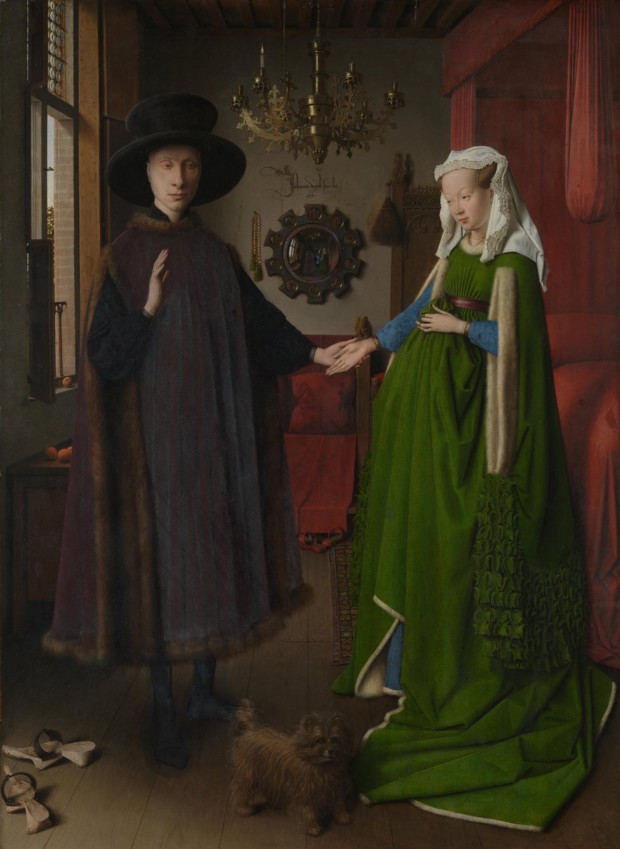
I read in my research around the Court of Spain during King Phillip IV’s reign that financially the court was suffering. Some scholarly articles refer to them as not having wood and food. It blows my mind that the image of Las Meninas gives such an elaborate idea of life in the castle – that idea that we mirror what is on the outside, but hide truths, came to mind.
My thinking is around what is a reflective surface – is it a perceptual phenomenon? I am aware of many artists who explore the use of technology/materials like glass, neon, resin, fluorescent light, and or volume and scale to create these phenomena.
Thinking then again about the mirror as a stage – should I focus on creating the perfect mirror form, or work on identity, psychological states, memory, experience, the sublime? painting distortion? Is a mirror telling/showing me about how we all see differently, but at the same time share that sameness of an experience?
I thought about mirror writing and tried to write my name as if someone will read it in a mirror. I am lefthanded, but do not find it easy to move from Right to Left on the paper. I read that Leonardo Da Vinci, was left-handed and that he wrote many manuscripts in mirror writing. Hebrew and Arabic language are read from Right to Left, a mirror reverses from left to right.
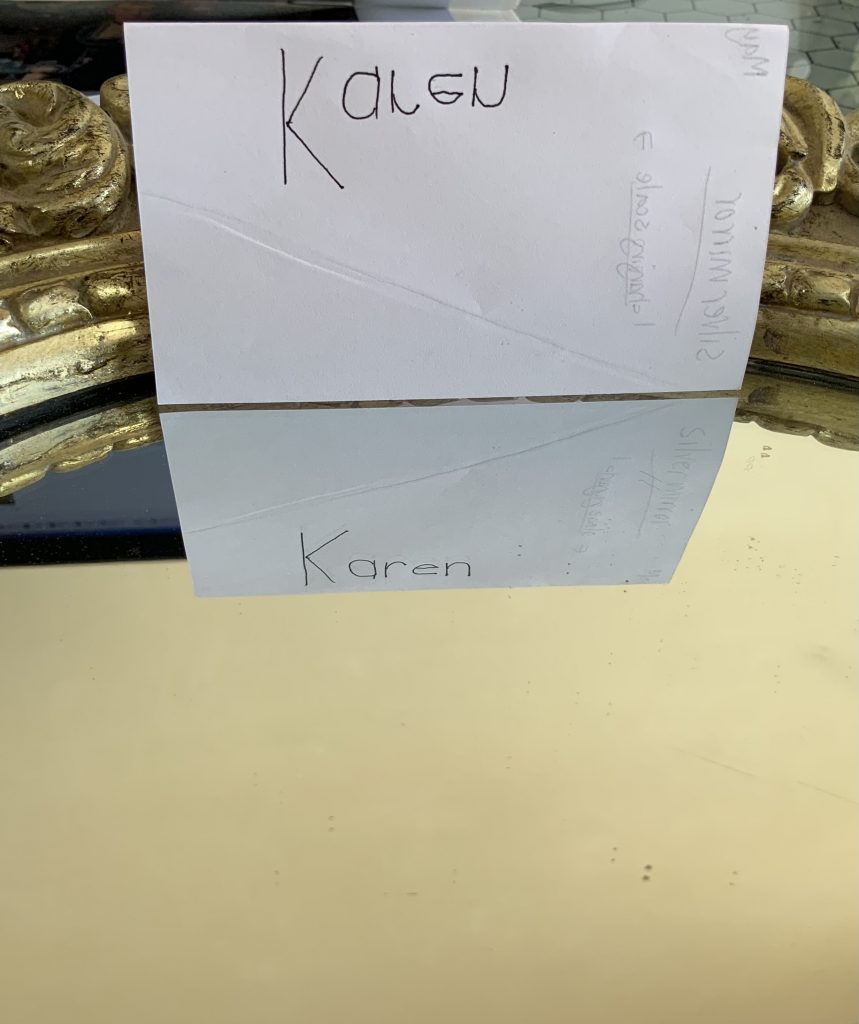
Fig. 3 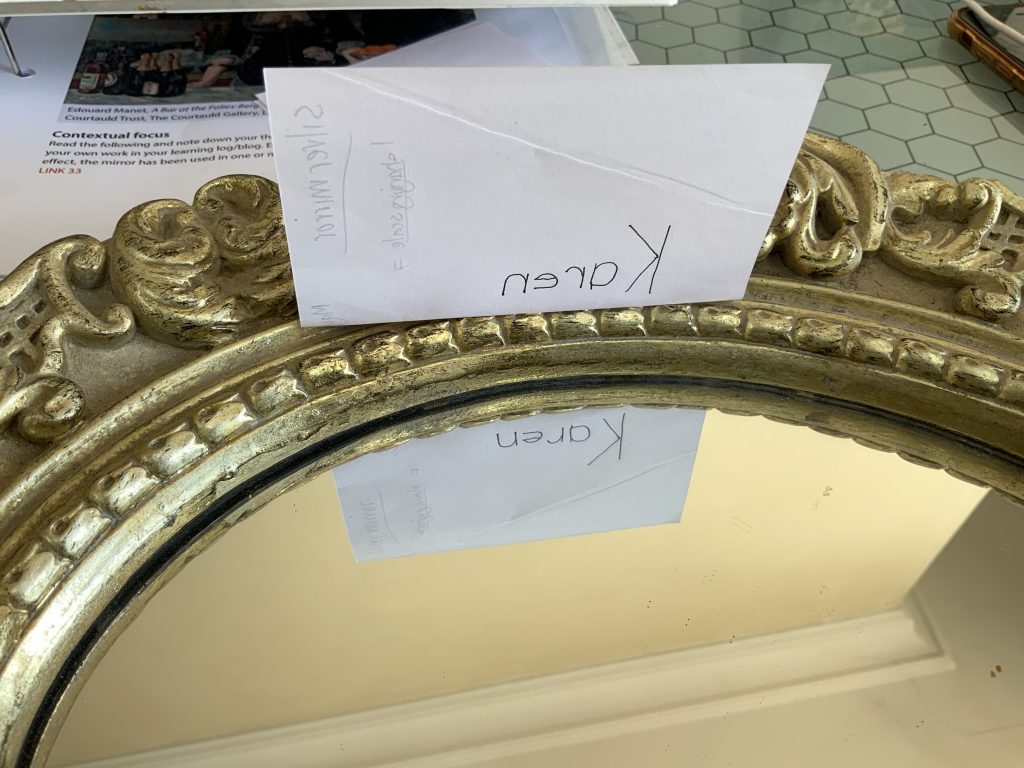
Fig. 4
The author, Lewis Carroll, experimented with spatial as well as logical inversions. Apparently, he was a skilled mirror-writer and amongst the 100,000 letters that he wrote were a series of ‘looking glass letters, designed to be read in a mirror. Mirror-writing also appears in his stories and poems. In Through the Looking-Glass one of Alice’s first discoveries is a book printed in mirror-script.
Over the years I have taken many reflective photos in water or in mirrors – I am captivated by these images as transient memories and have at a time considered to work with concave mirrors – but never pursued the idea. Memories of a visit to Venice (Bienalle 2019) come to mind. Below are some of my own images: the first three photos were taken in Venice, and the rest on the farm and at the beach photo and made images around the reflection. Light seems to be what is caught and enjoyed in these momentary images.
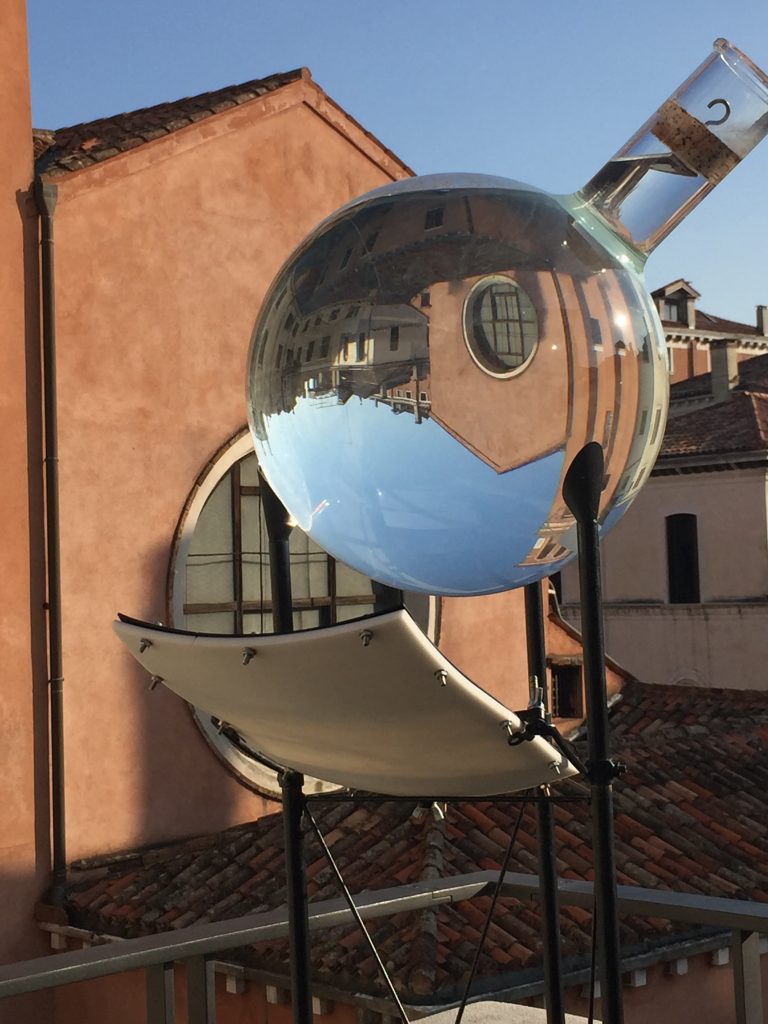
Fig. 5 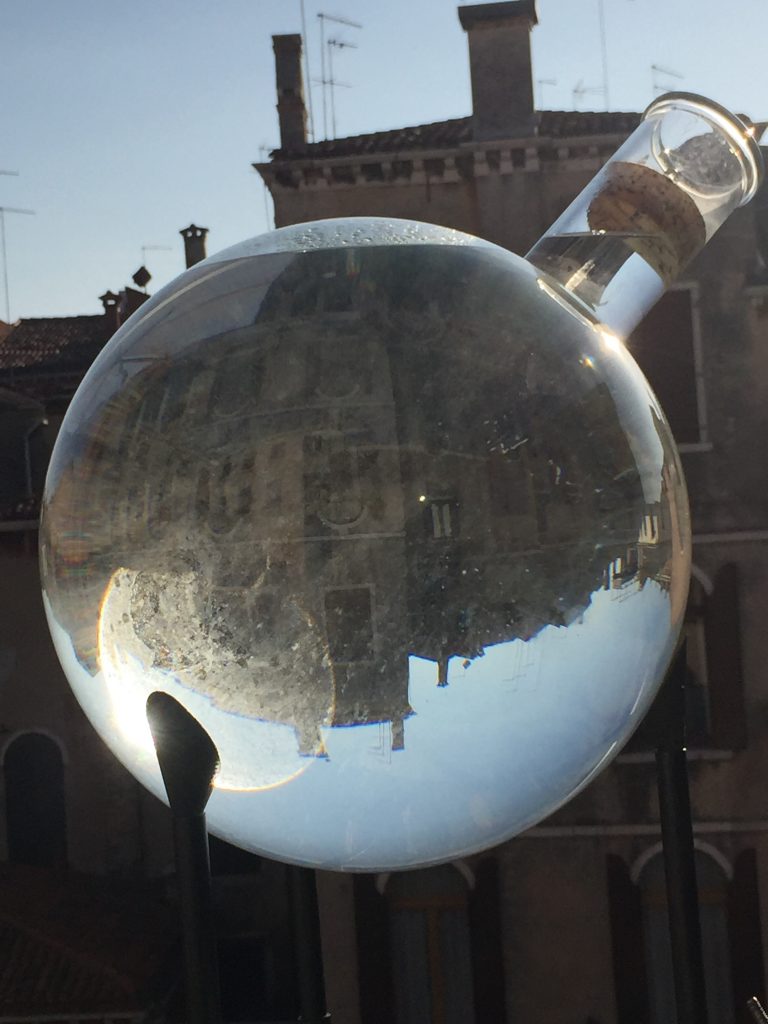
Fig. 6 
Fig. 7 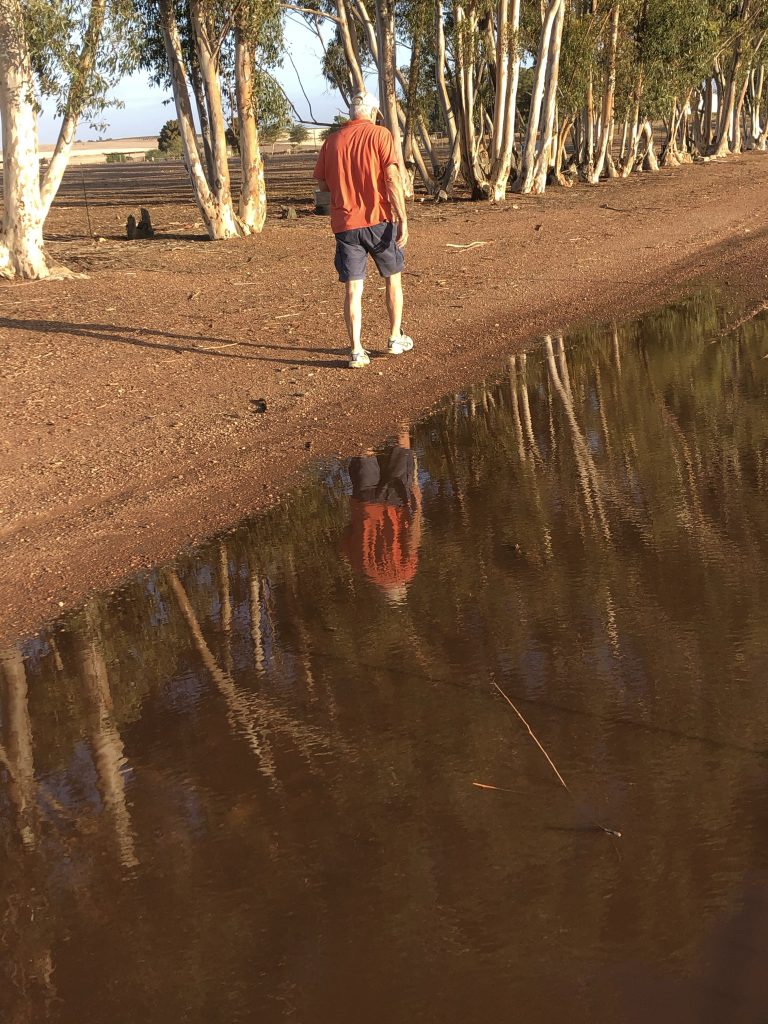
Fig.8 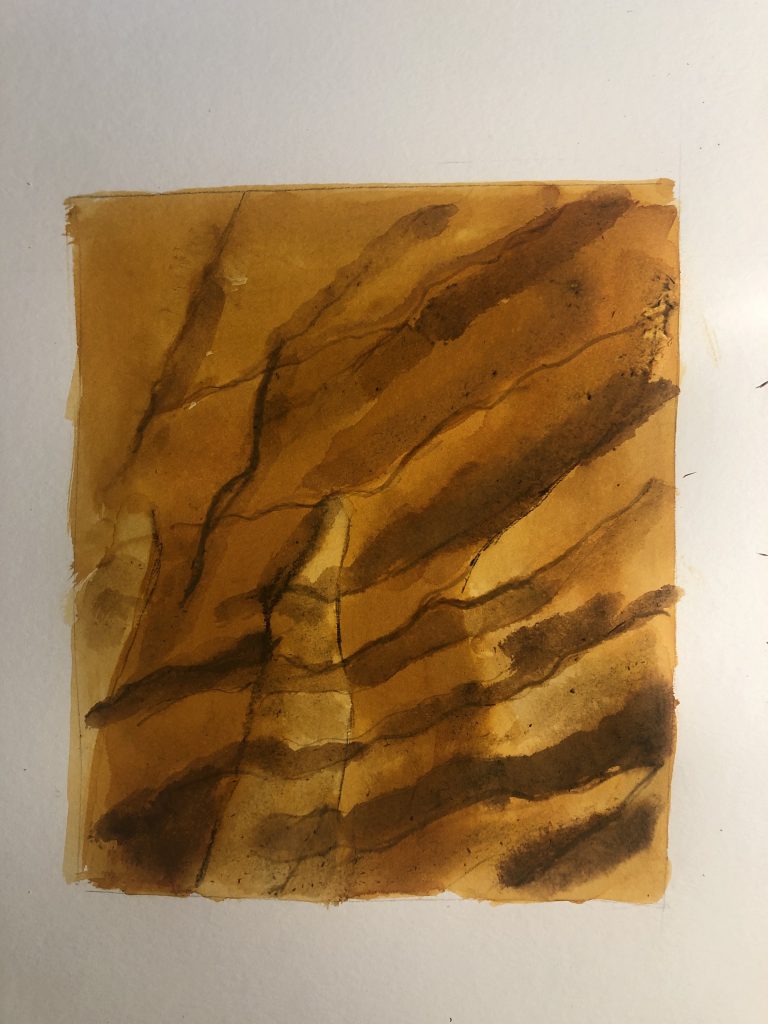
Fig. 9 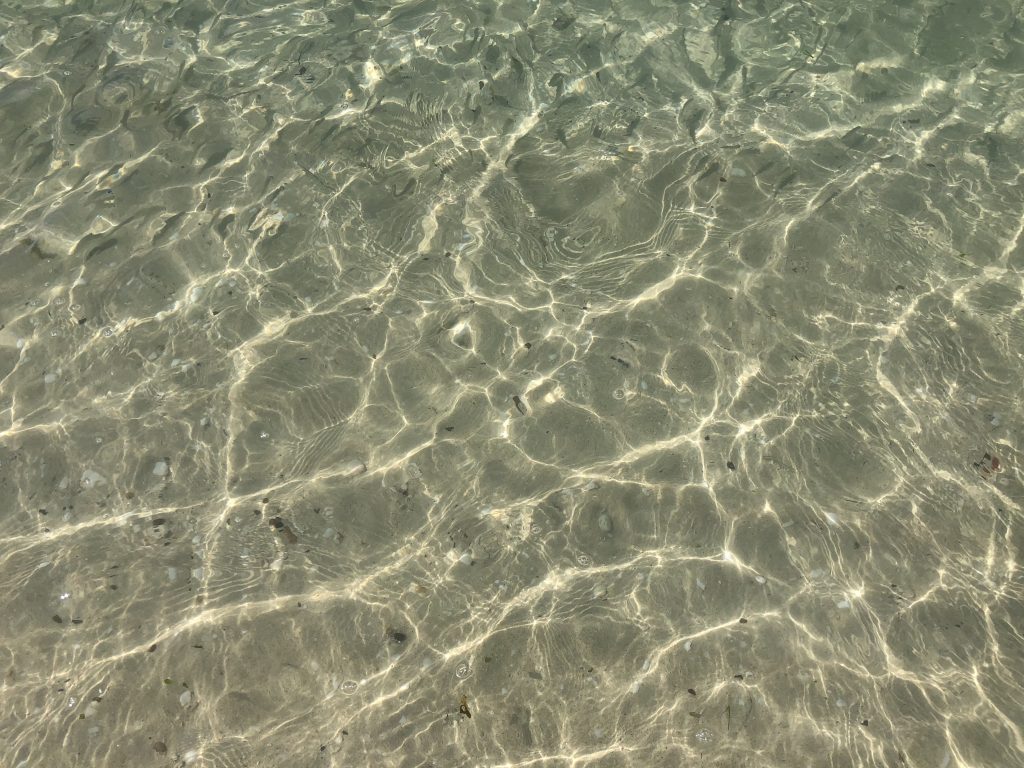
Fig. 10 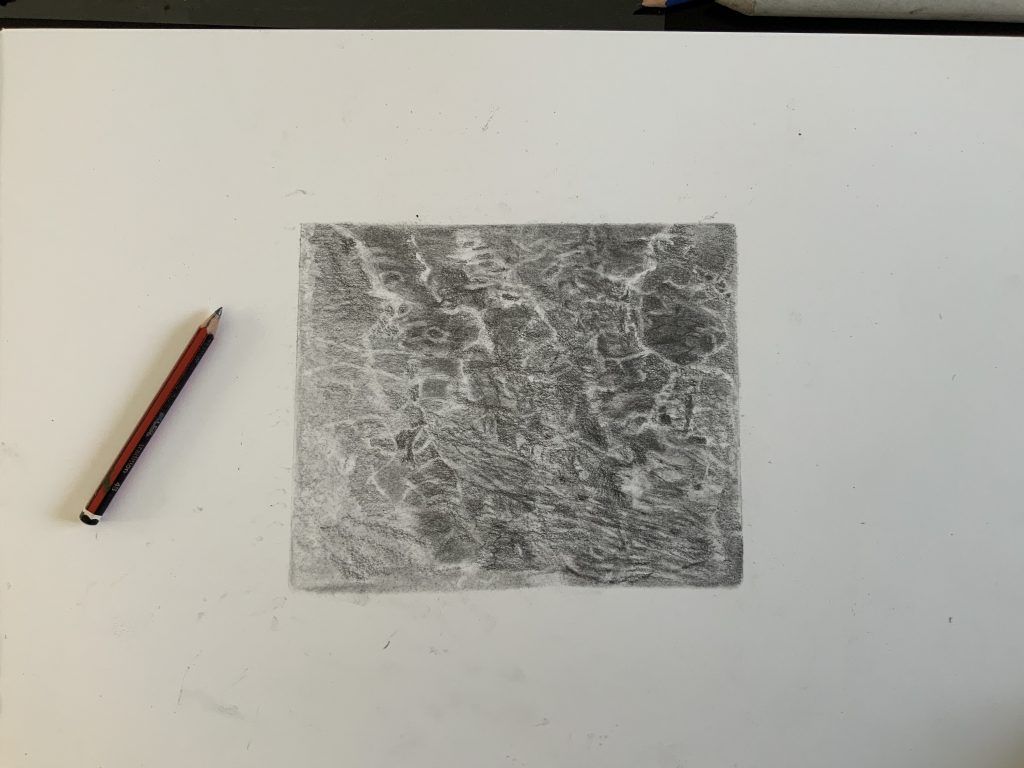
Fig 11
Method:
I started exploring ideas of looking at a glass filled with water. I placed a mirror in front of the glass and started drawings in charcoal and then in ink washes. In my studio the outside was ‘mirrored’ in the glass of water, leaving a small area with blue sky and the green leaves of a tree. With the charcoal, I did some blending with an eraser as well as my fingers. The reflection of colour was what mostly drew me to explore the drawing with ink as the water became a mirror from different angles, the smoothness of the water acted as a mirror.
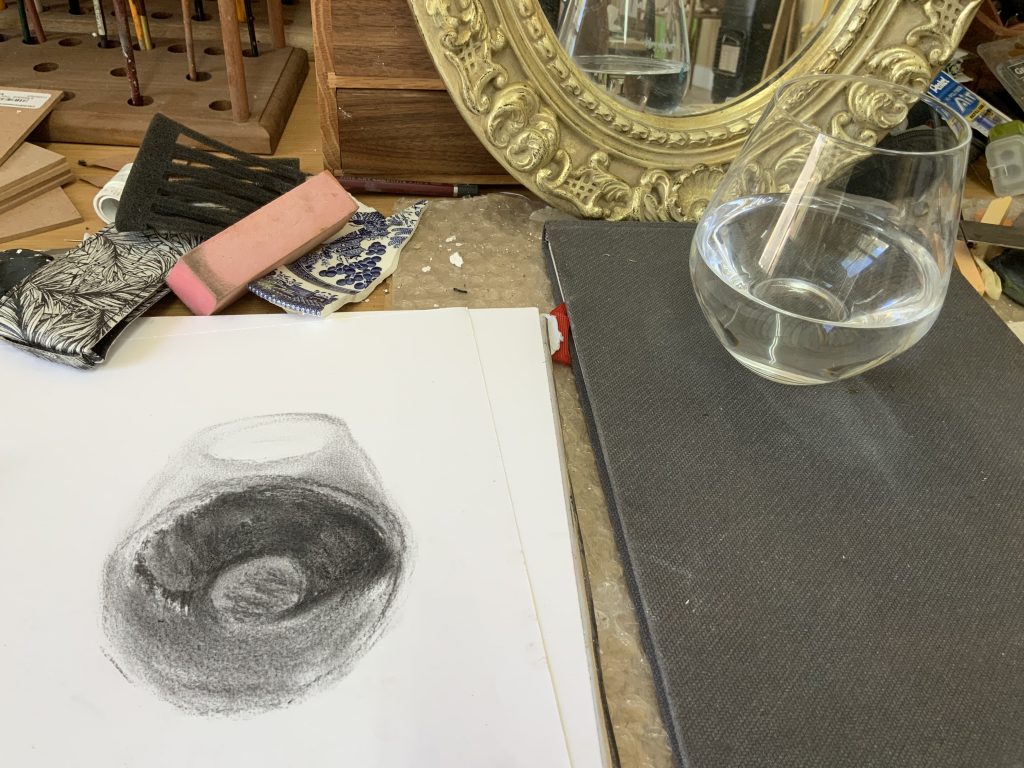
Fig. 12 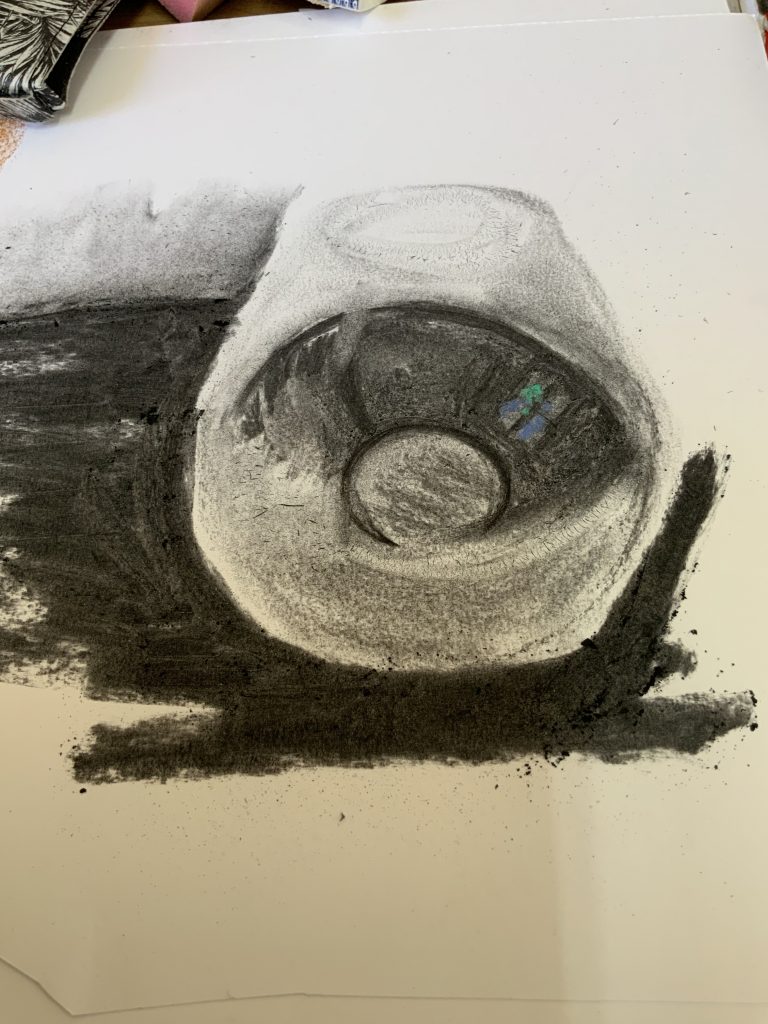
Fig. 13 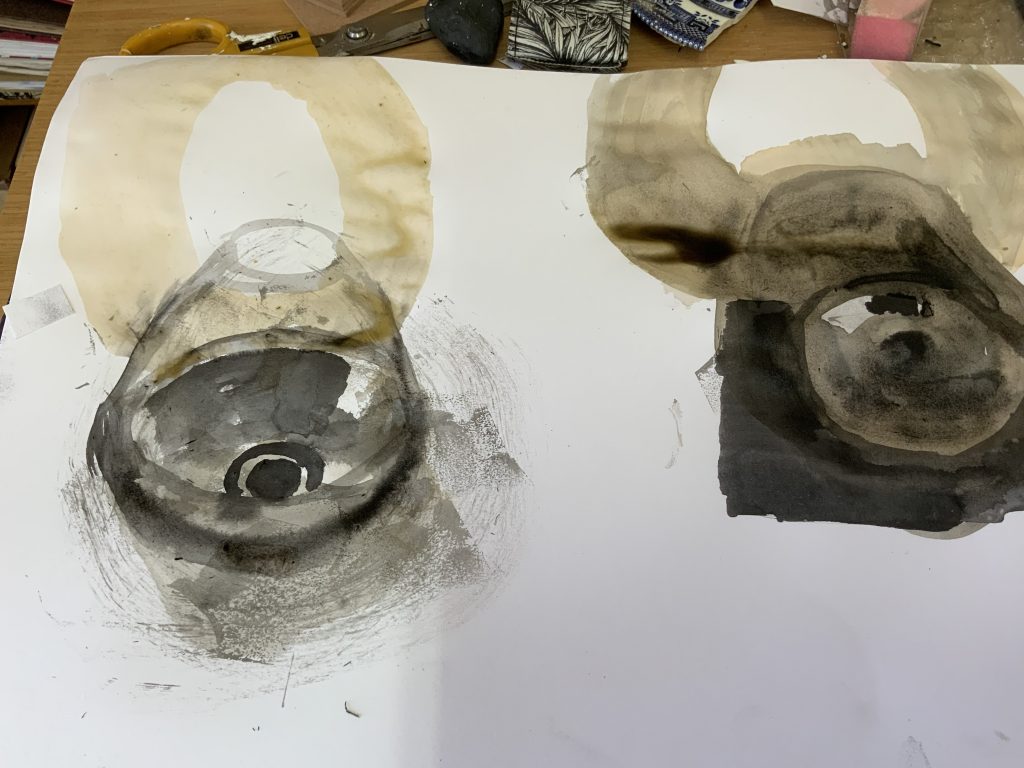
Fig. 14 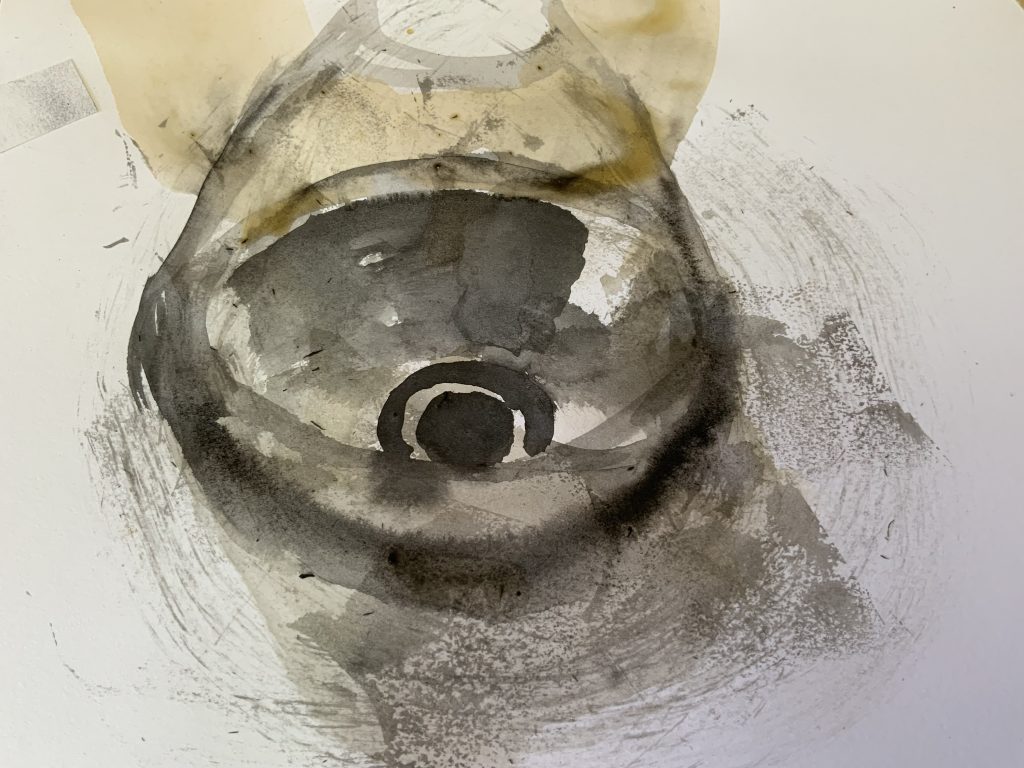
Fig. 15
The image in the study material prompted me to look at the water when ink was mixed with: fleeting moments will be so much more. I consider using a camera and clicking through the process, and replay it to make a painting or study of paintings.
At this stage, I was only using two colours, black and umber/yellowish tones. As I was trying to work on the wet water-colour surface I battled when the two colours mixed. I tried to make an imprint of the wet colour and continued with this process, adding more wet colour, then imprinting on dry paper. The last image is a mirror reflection or transfer of the previous and becomes the stage for the next image.

Fig. 16 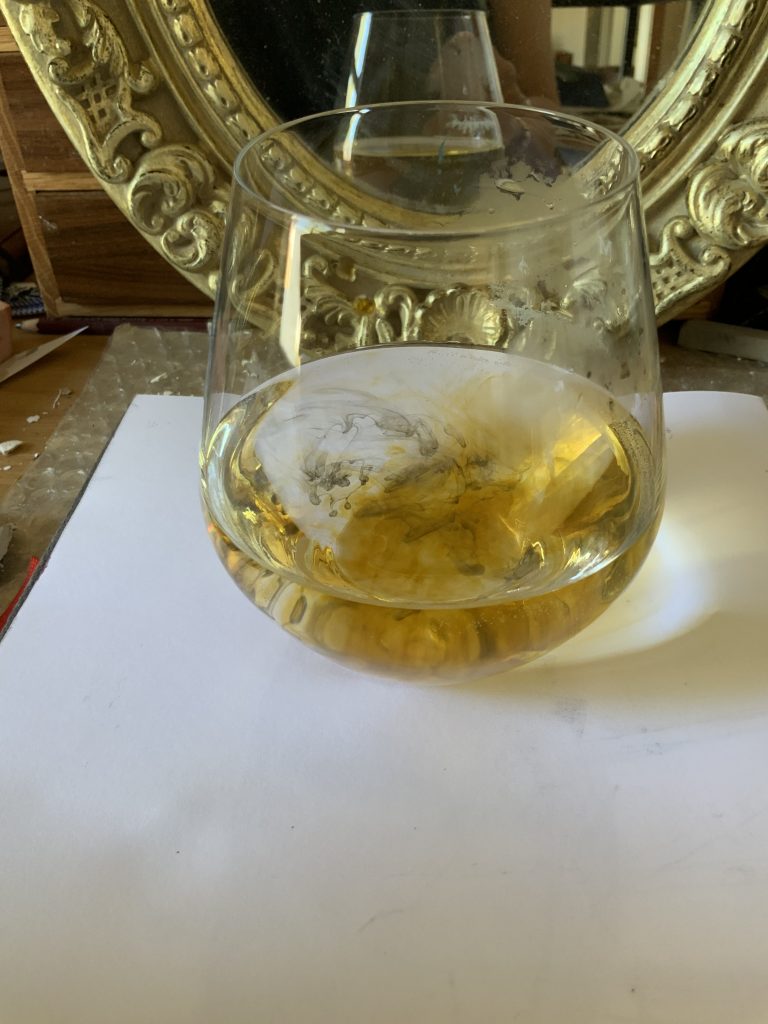
Fig. 17 
Fig. 18 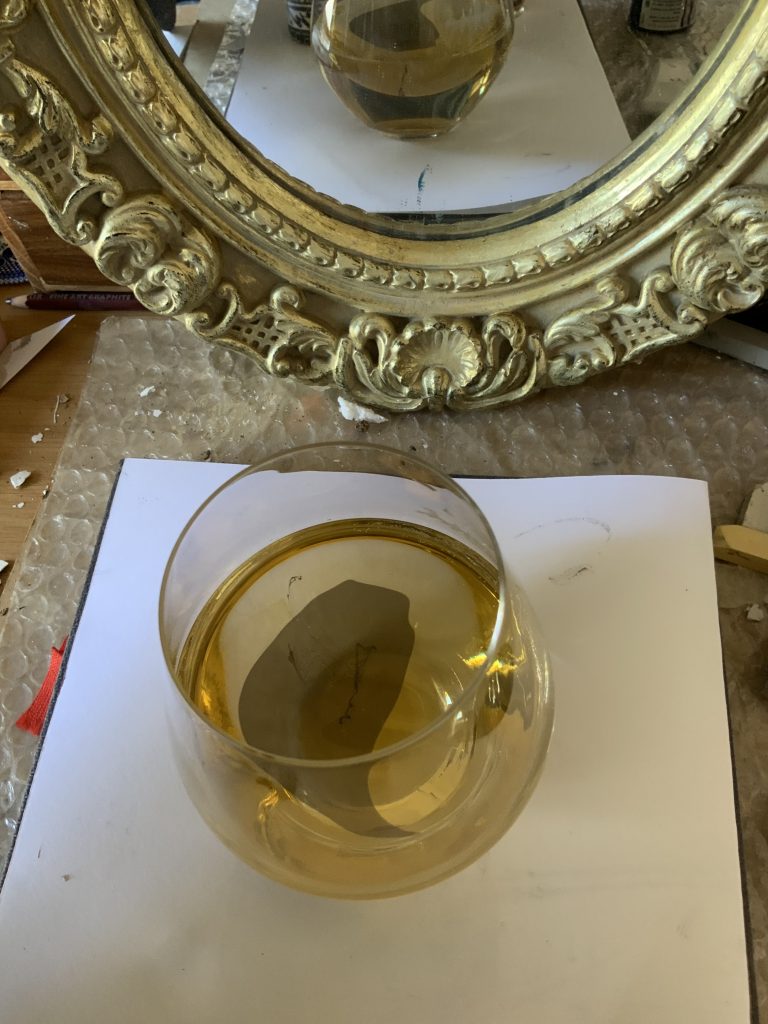
Fig. 19 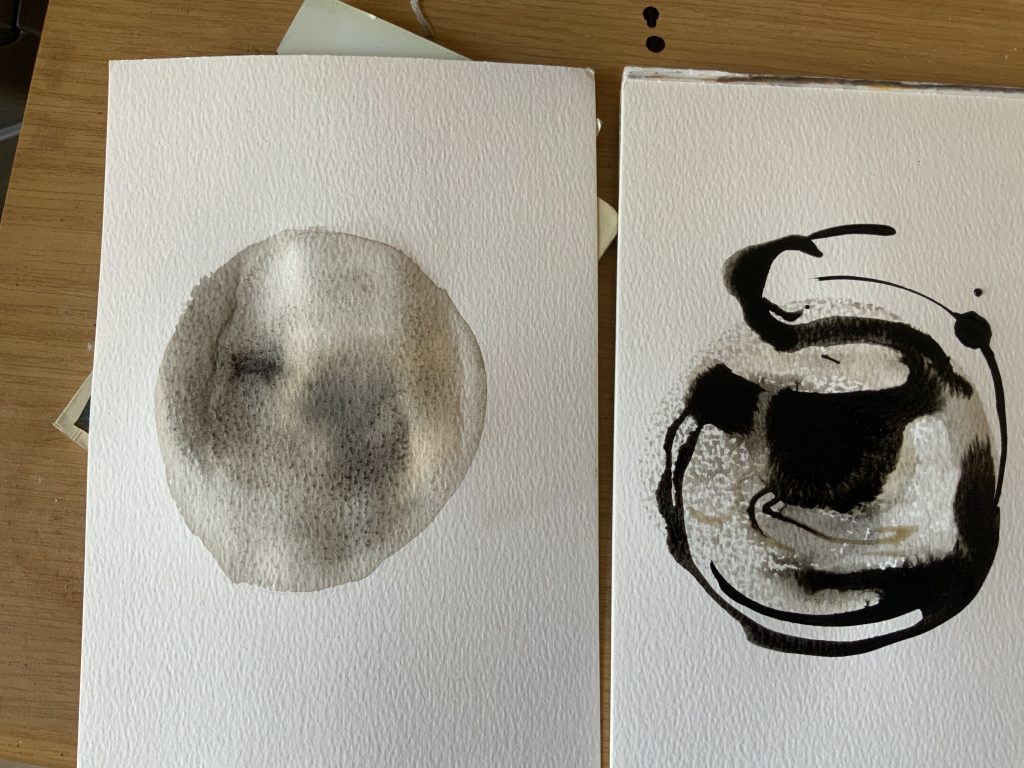
Fig. 20 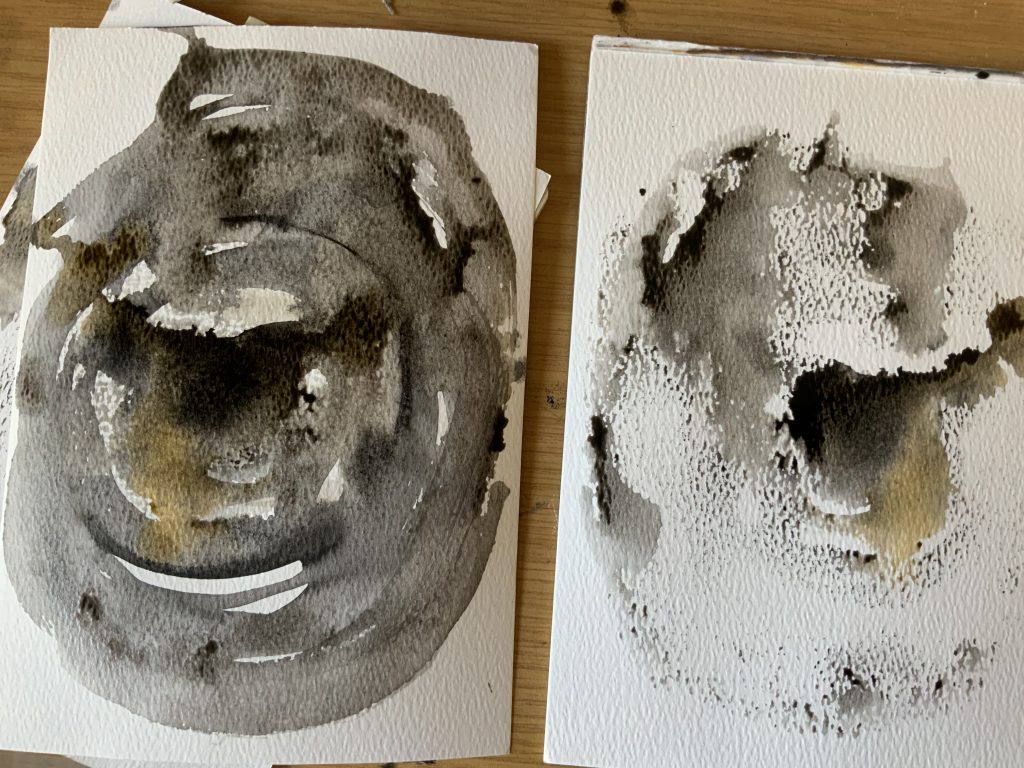
Fig. 21 
Fig. 22 
Fig. 23
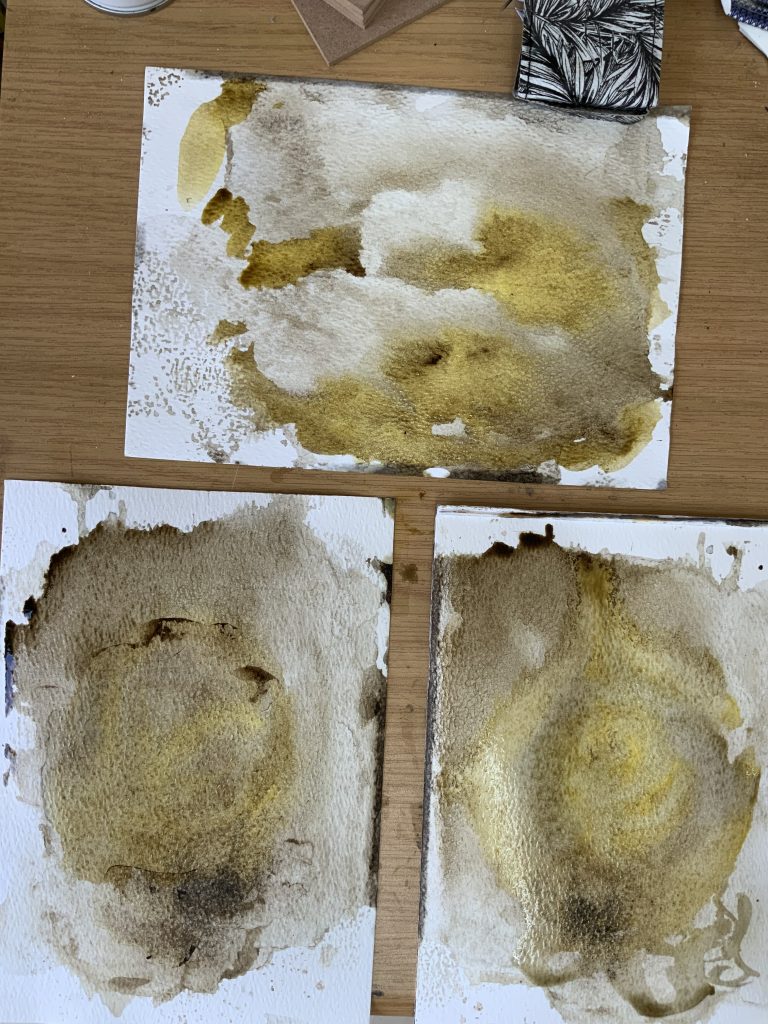
Fig. 24 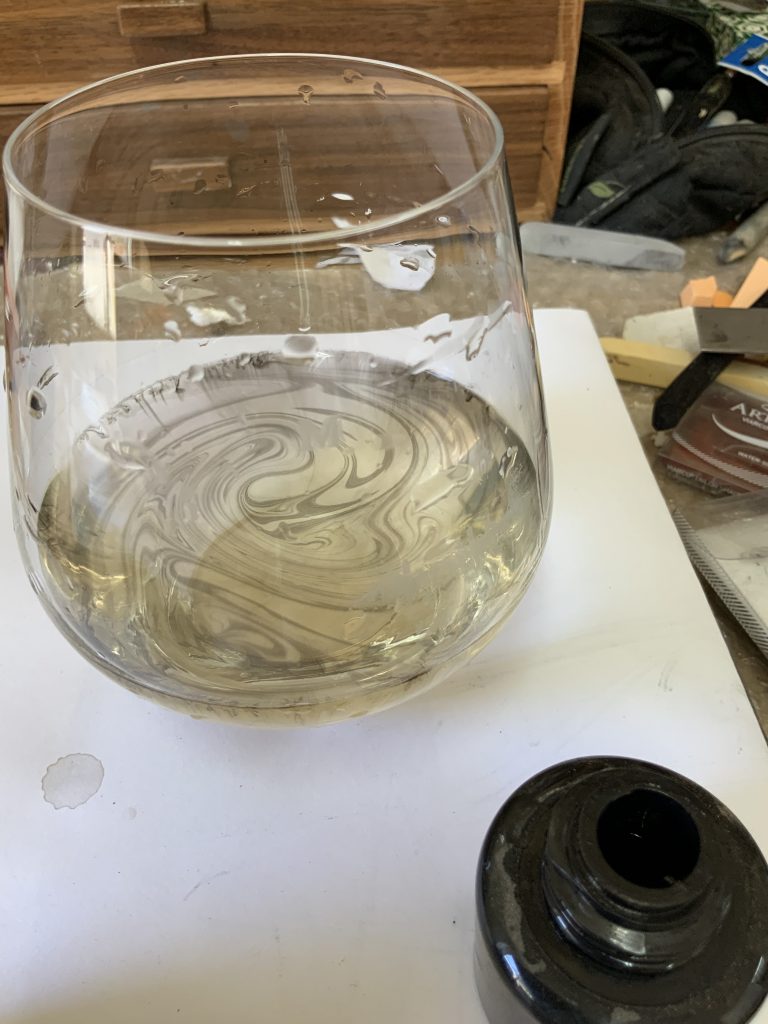
Fig. 25 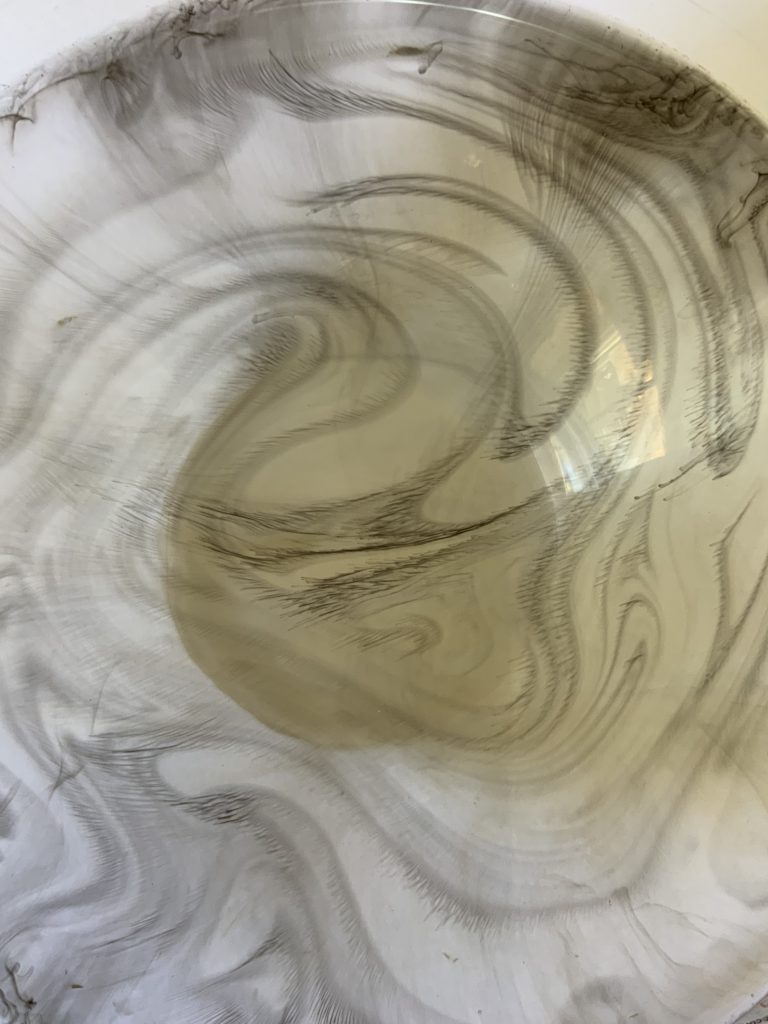
Fig. 26 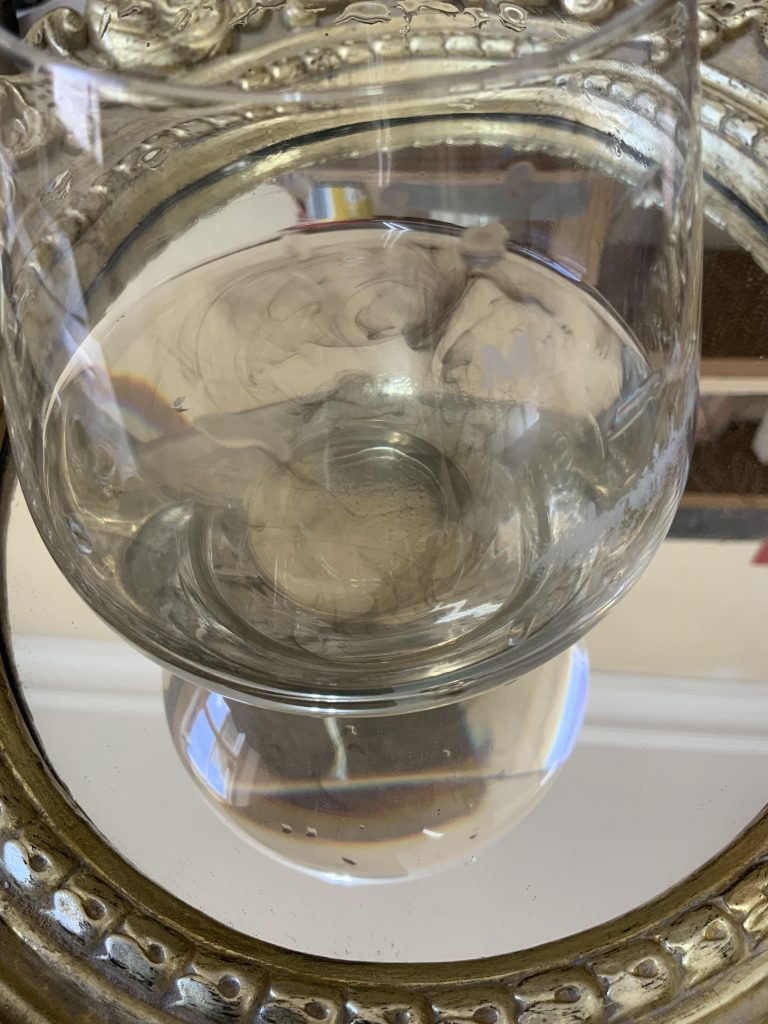
Fig. 27 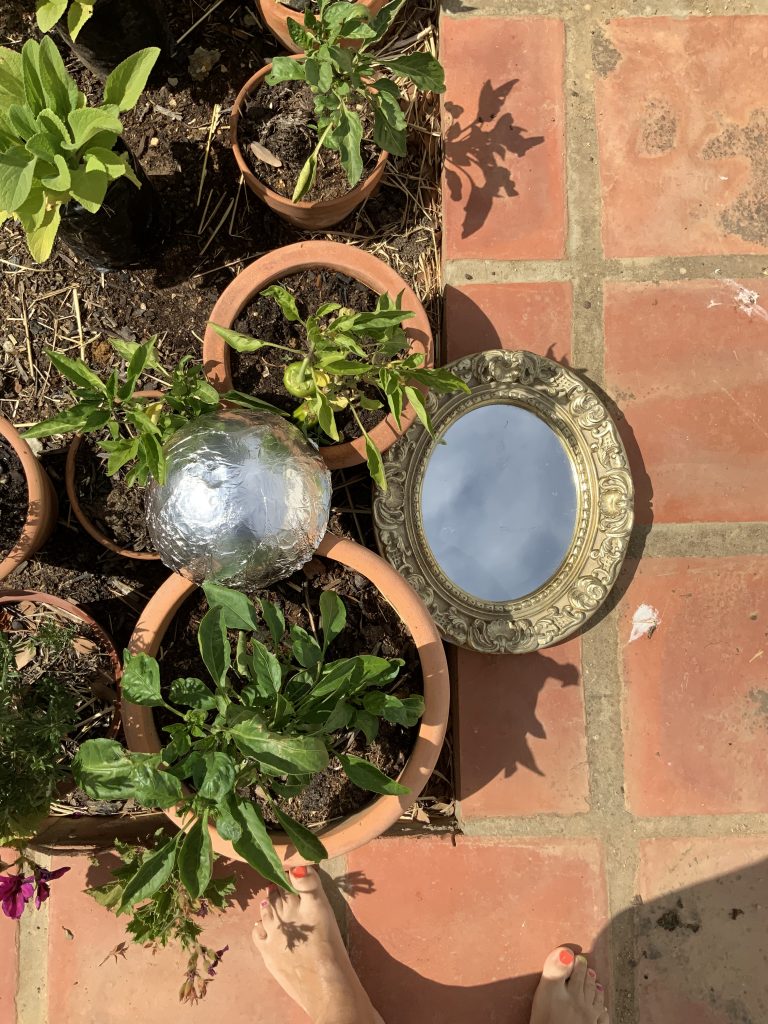
Fig. 28 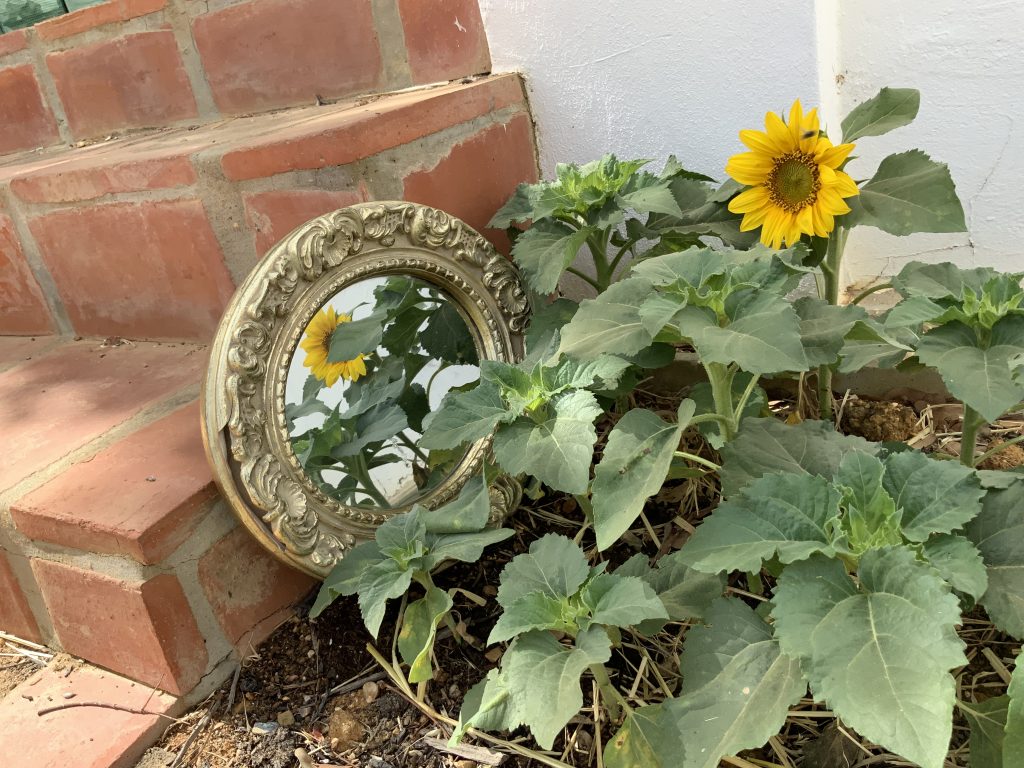
Fig. 29 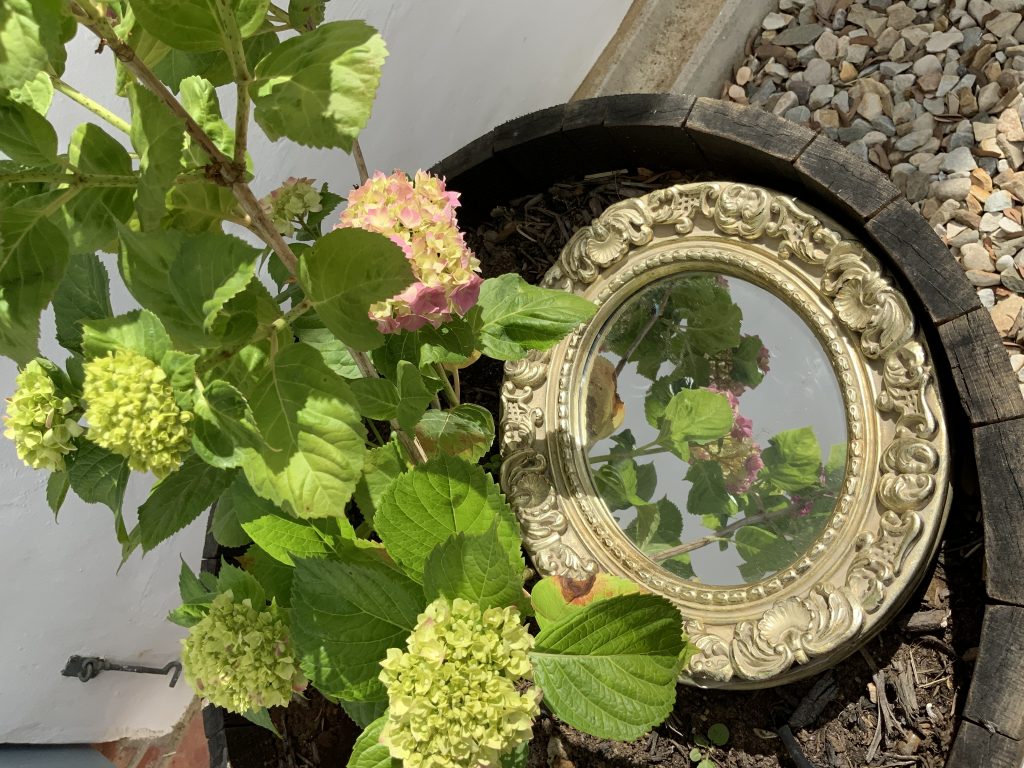
Fig. 30 
Fig. 31 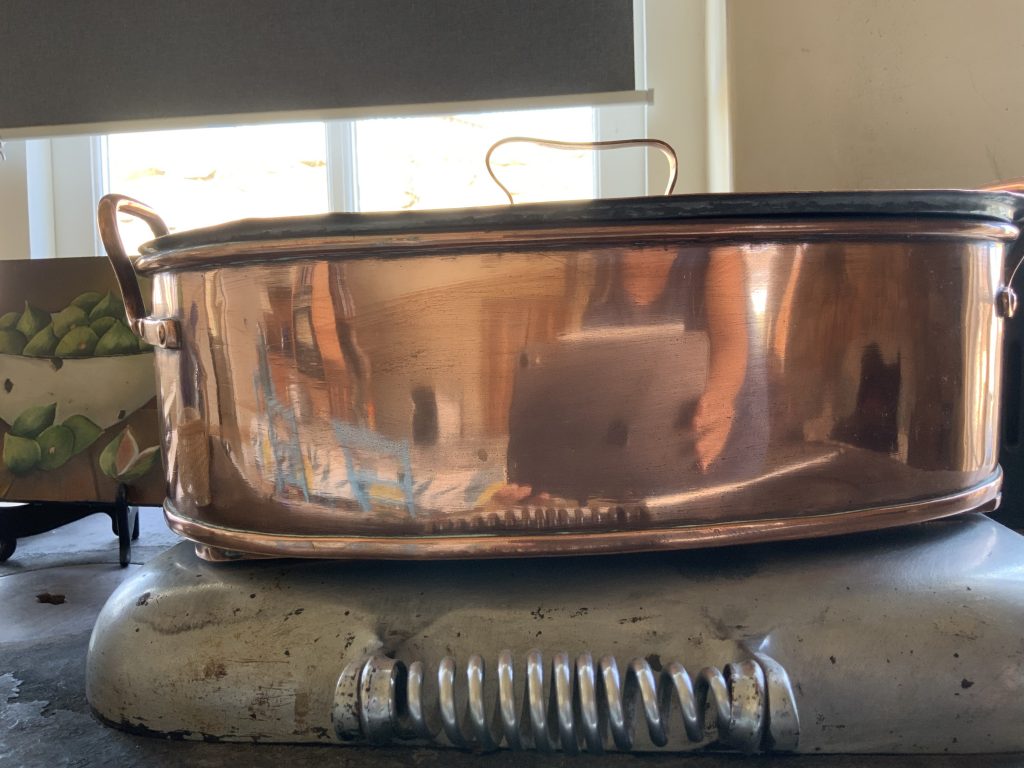
Fig. 32 
Fig. 33
I looked around my own environment, inside and outside to find reflection. Curved reflections are interesting to me. My attempt to make a curve object for observation with styrofoam and aluminum foil was not too effective. My favorites are the two similar images on the little dome shapes and the images around the dam in front of our house. Seasons can be read by the water in the dam and the growth around the dam.
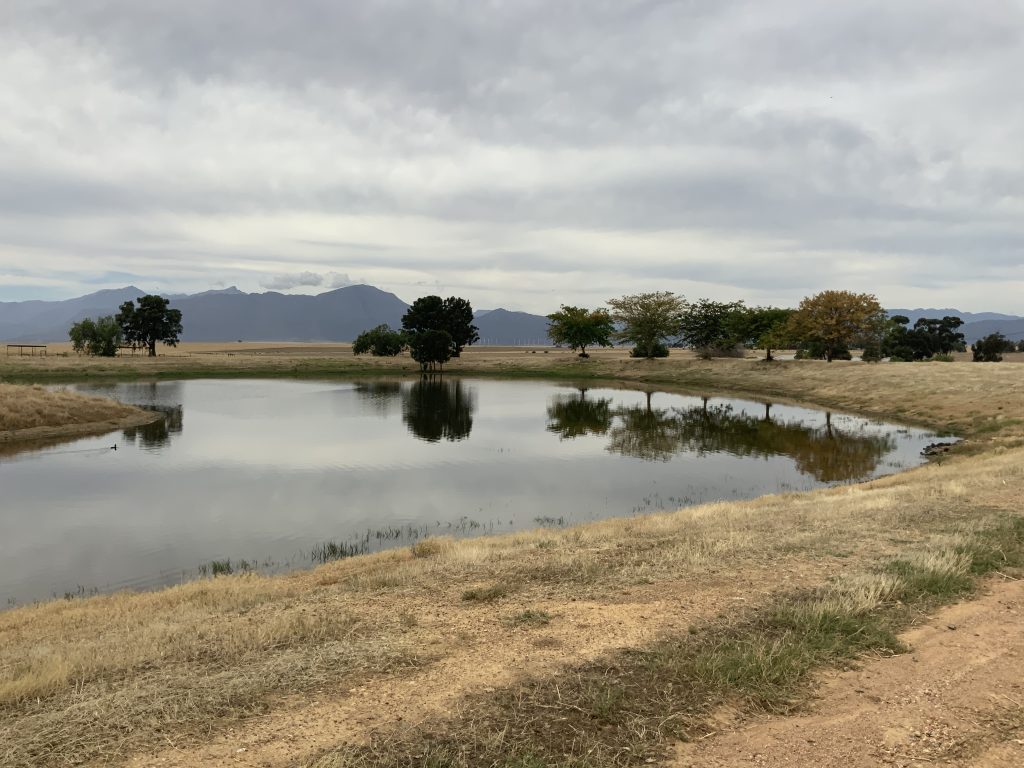
Fig. 34 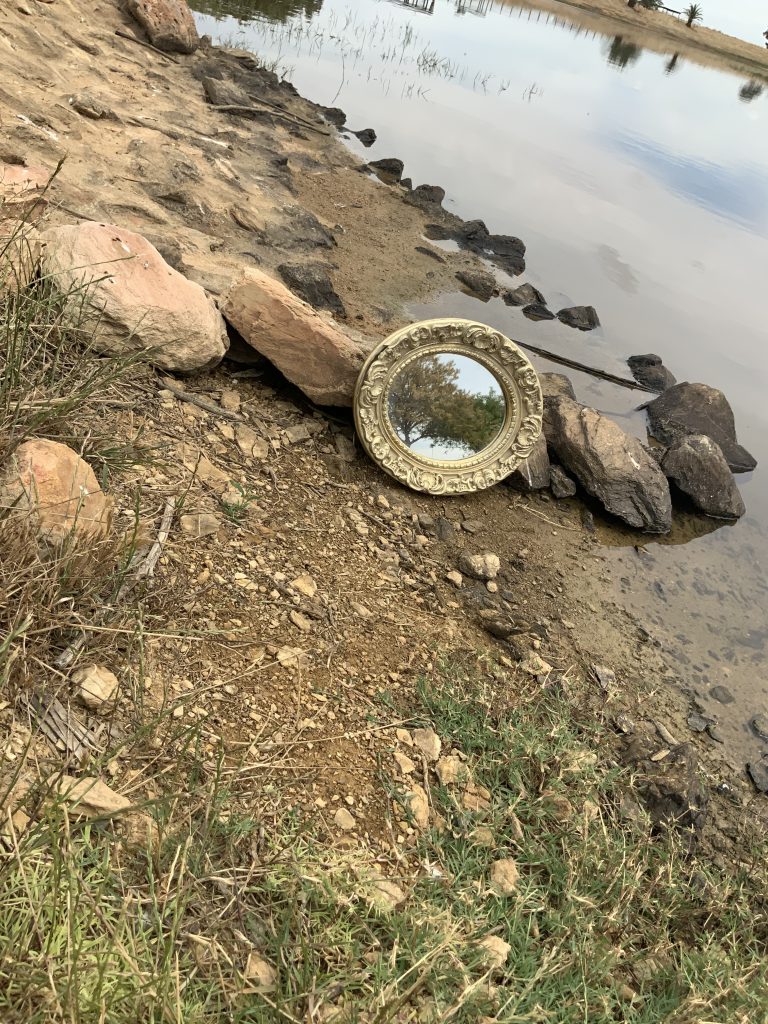
Fig. 35 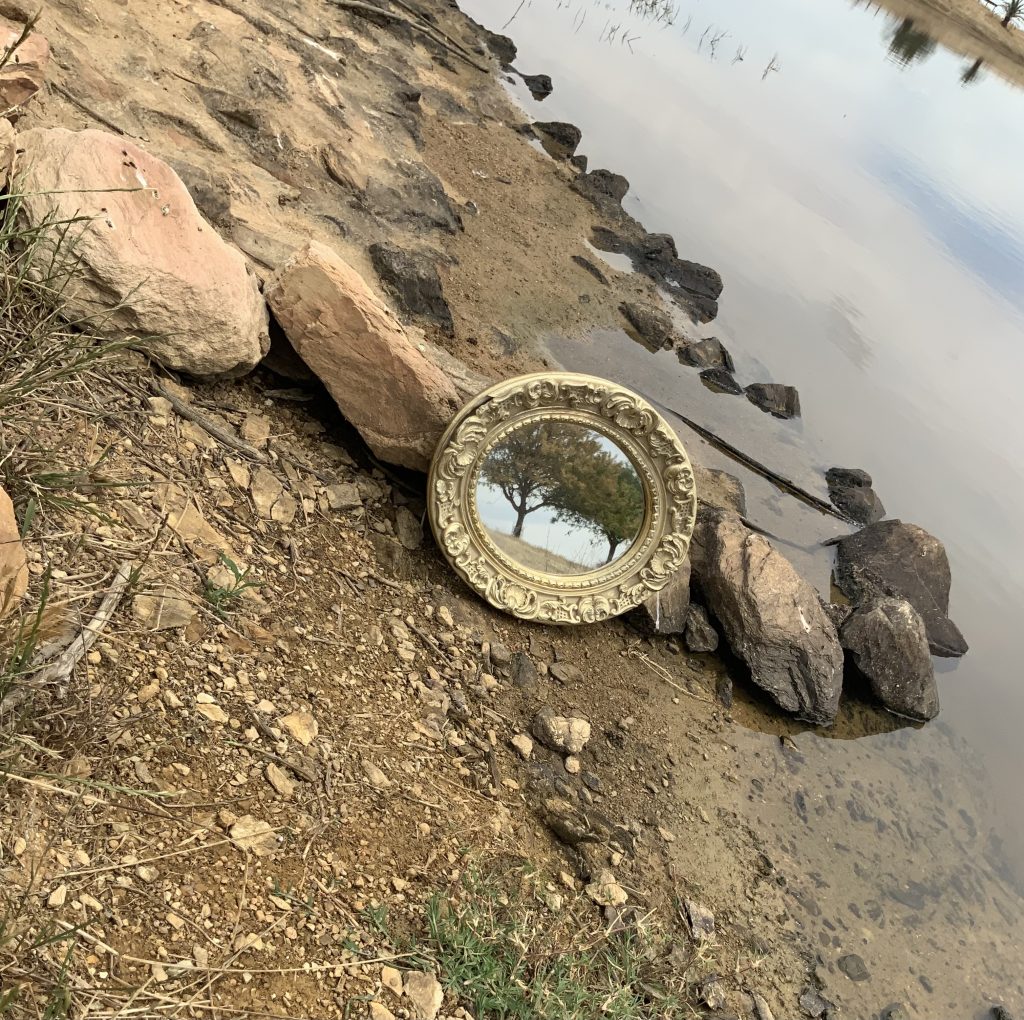
Fig. 36 
Fig. 37 
Fig. 38 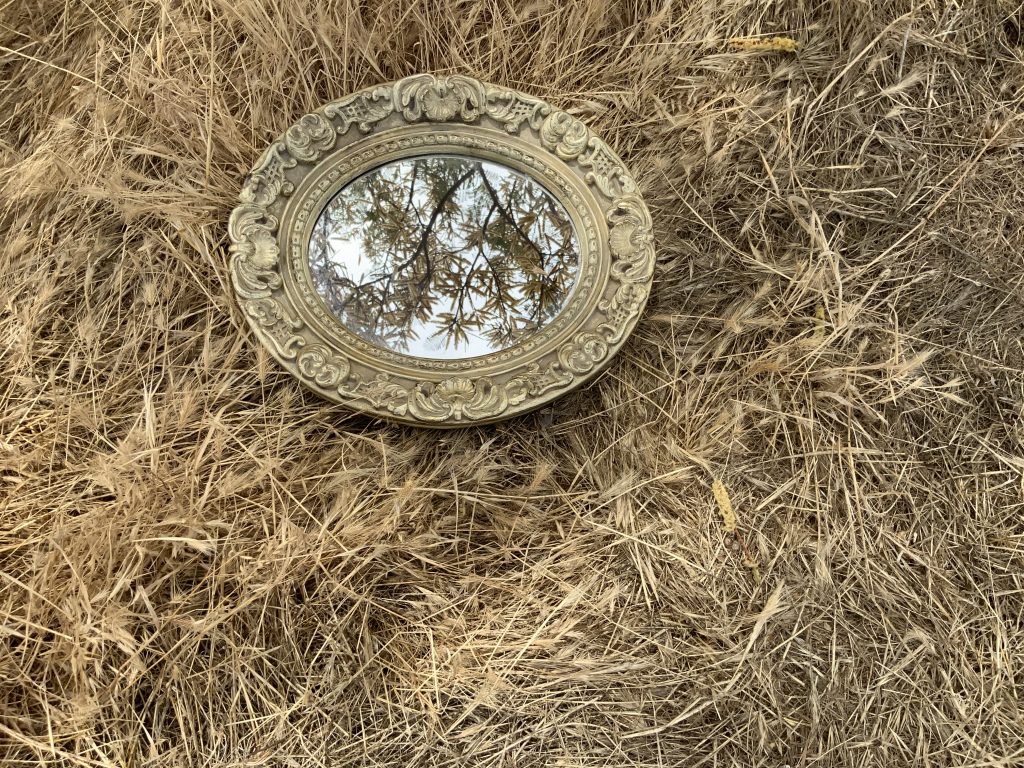
Fig. 39
I decided to concentrate on the research part as I was not sure what to paint. This experience has made me aware of how we/I interact with mirrors and reflections. I also consider how a mirror becomes the art – no representation, what you see is what is, or that it could refer to a concept, it could just be the vehicle. I discover that my fascination with the reflective surface in nature is around the double-image which is created by the reflection – the bottom half is an inverted copy of the top half, the symmetry is intriguing to me. In a way, this reminds me of infinity as a representation.
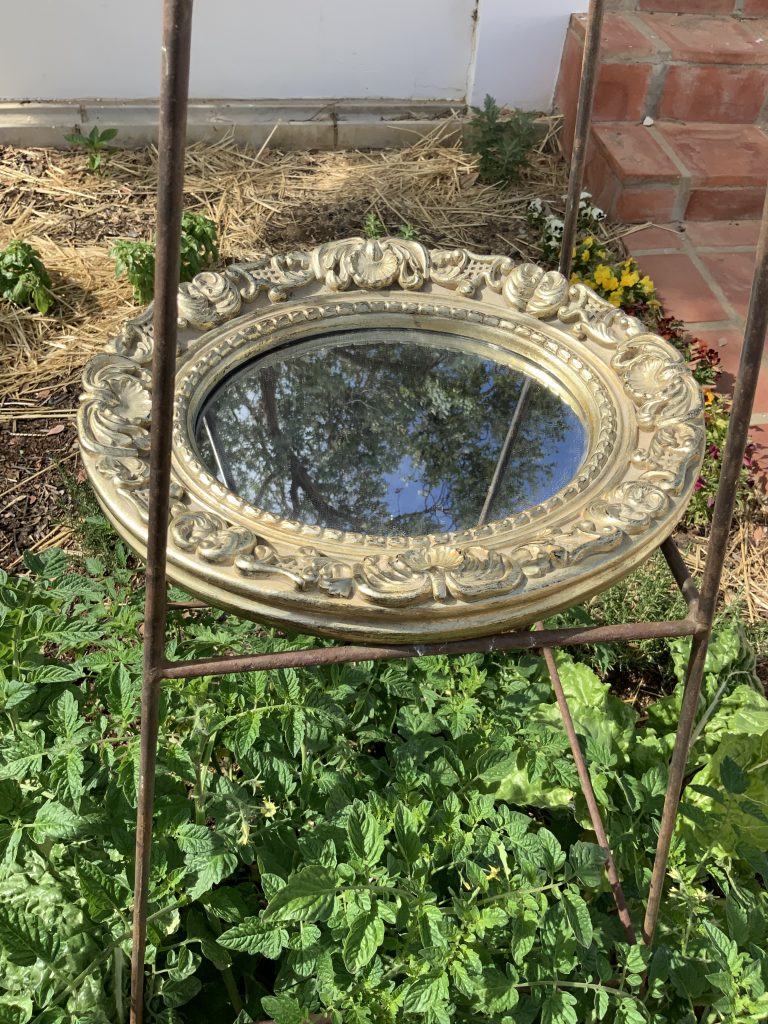
Fig. 40 
Fig. 41 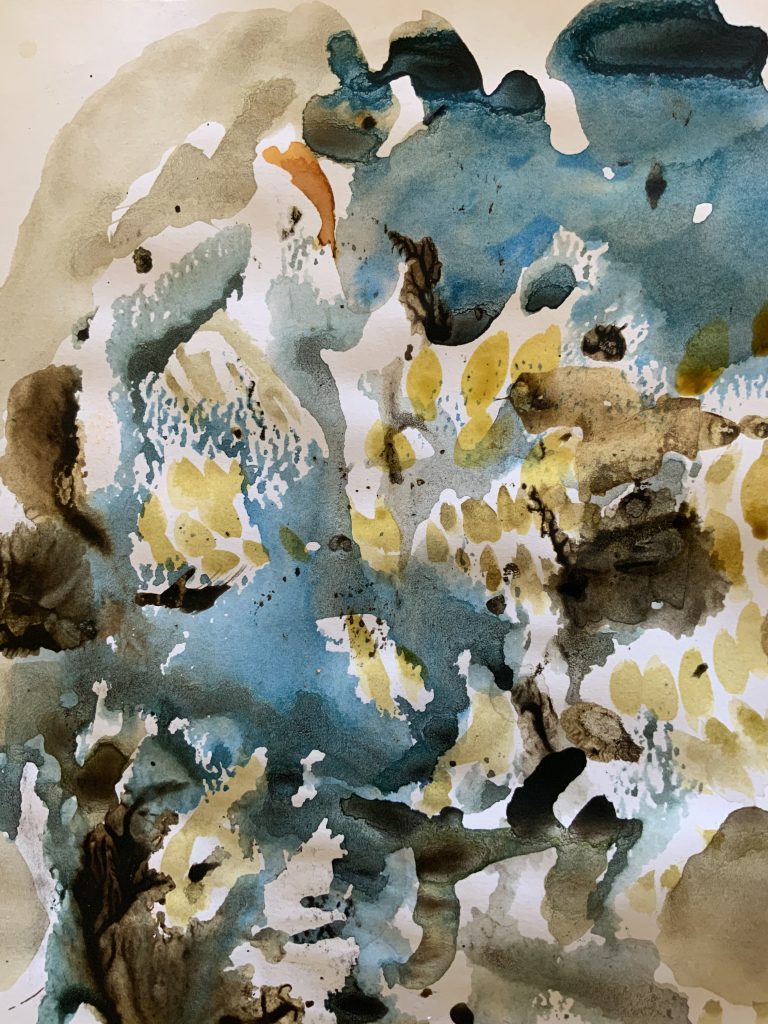
Fig. 42 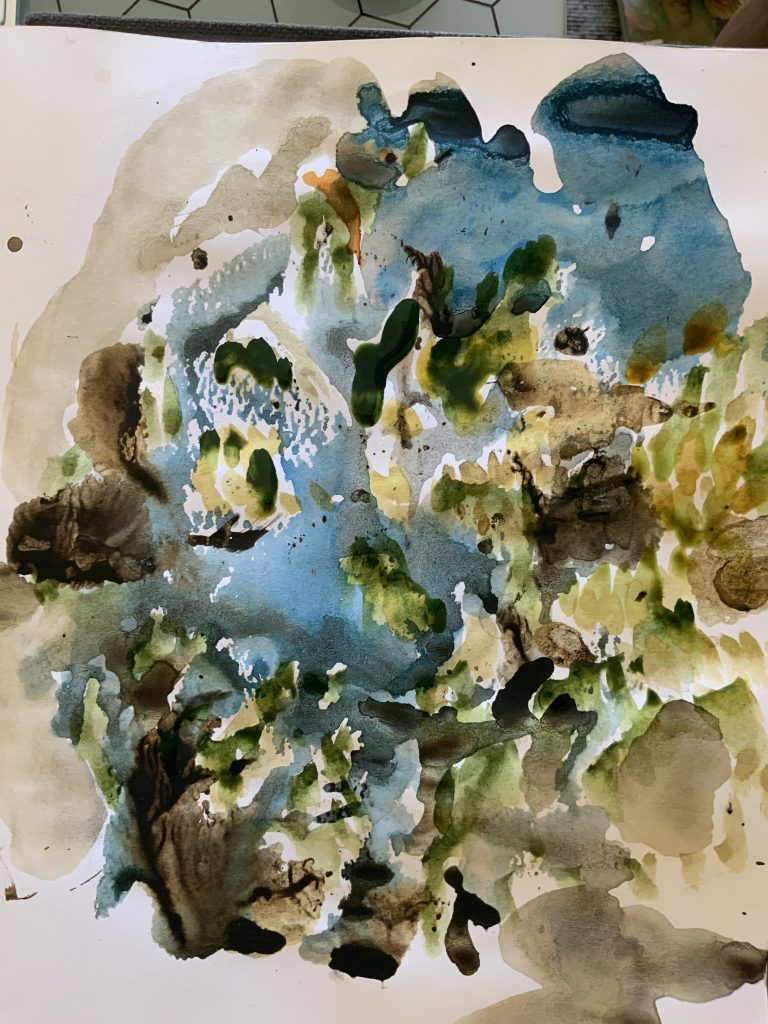
Fig. 43 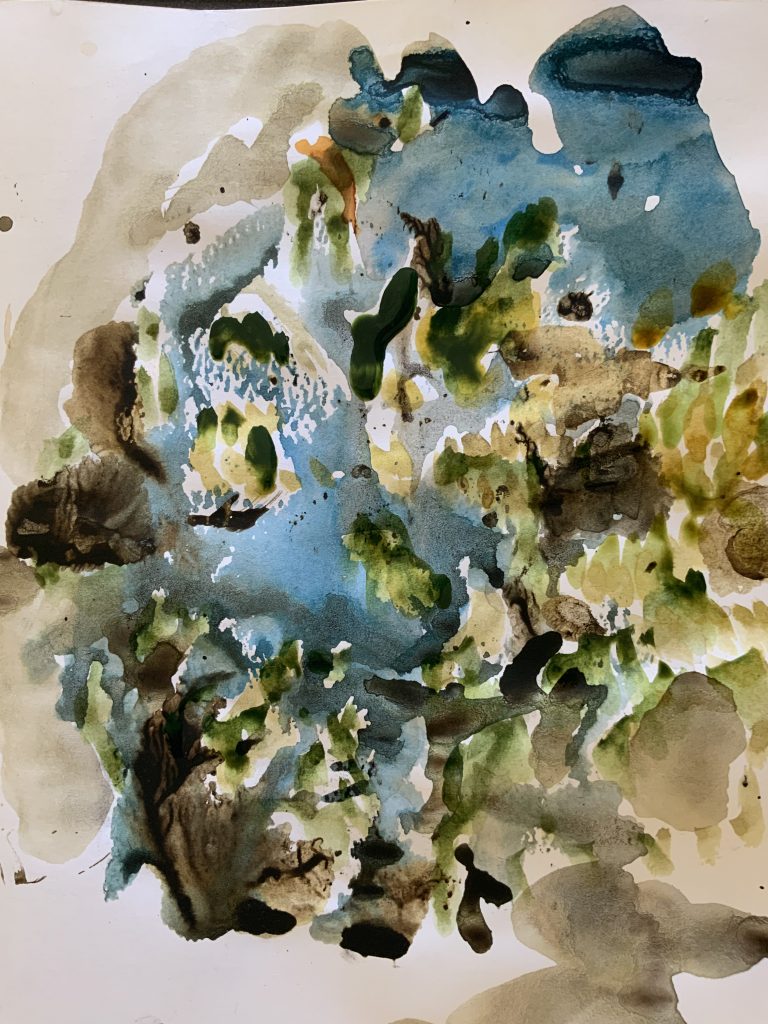
Fig. 44 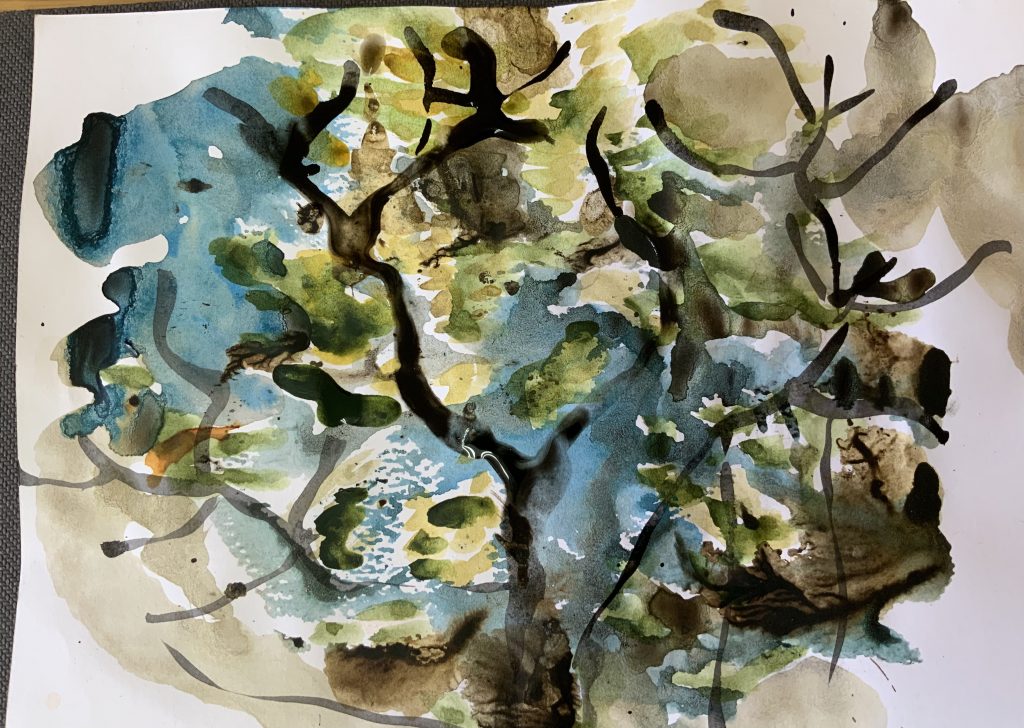
Fig. 45 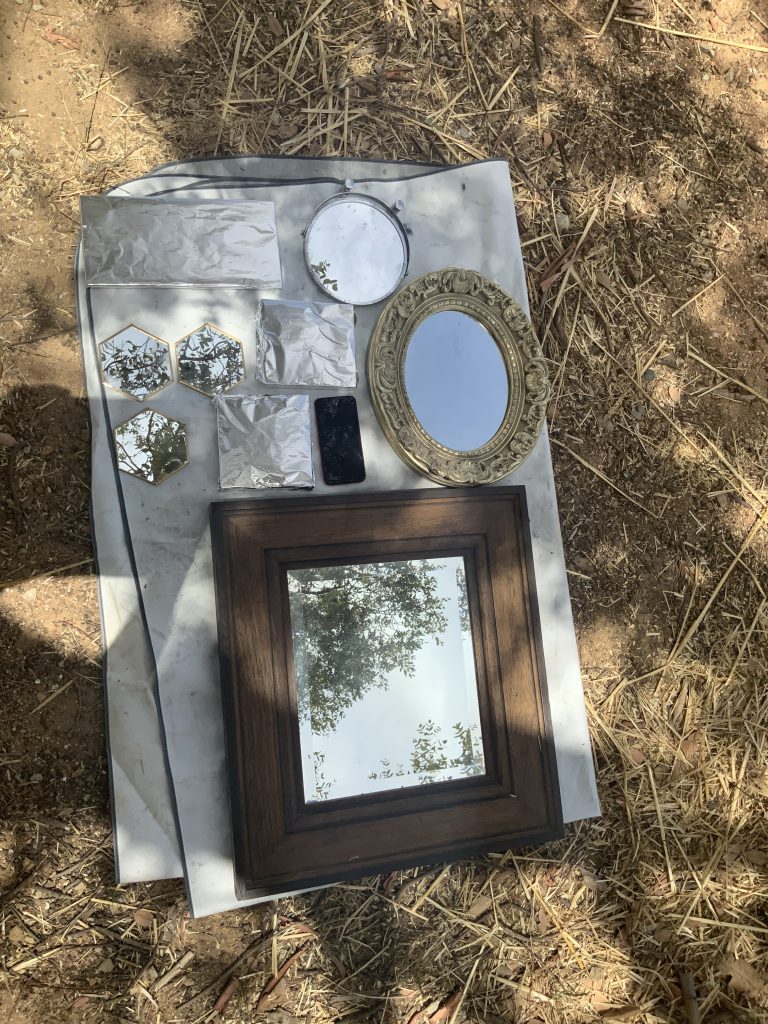
Fig. 46
In the last three images I used different materials (aluminium and different sized mirrors) as a stage and placed them under a tree. I placed my cellular phone amongst it and made videos of it. Each reflection is different, but still not reflecting everything in this space. It made me aware of different perspectives when looking. The video reflection has bird and insect sounds as well, movement is captured over time.
I did some painting to capture some of these performances:
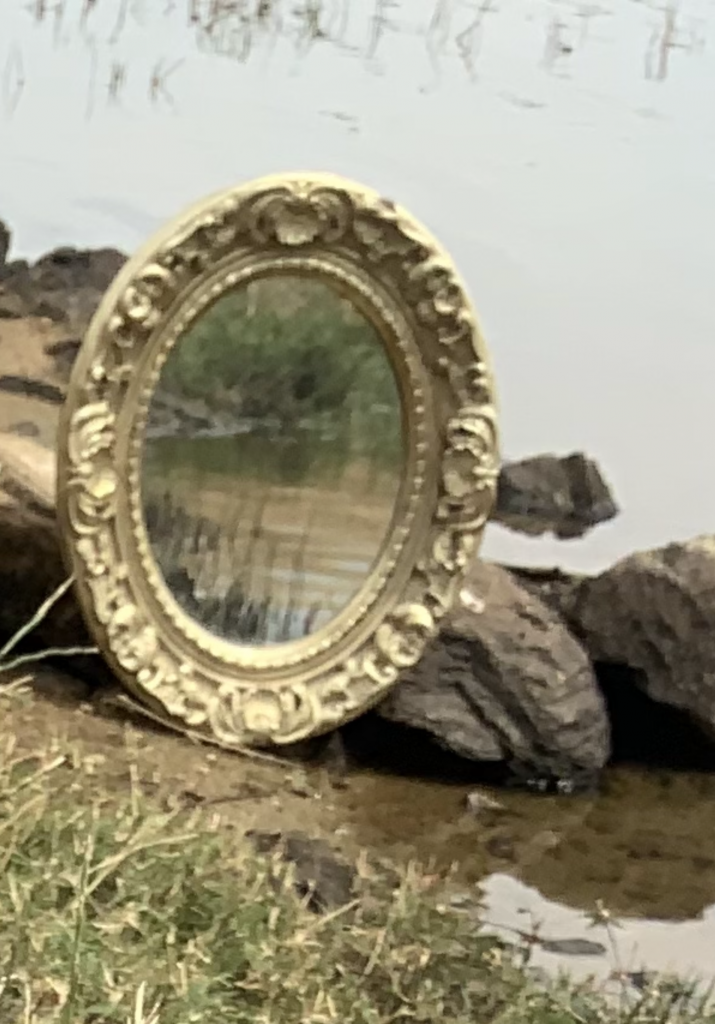
Fig. 48 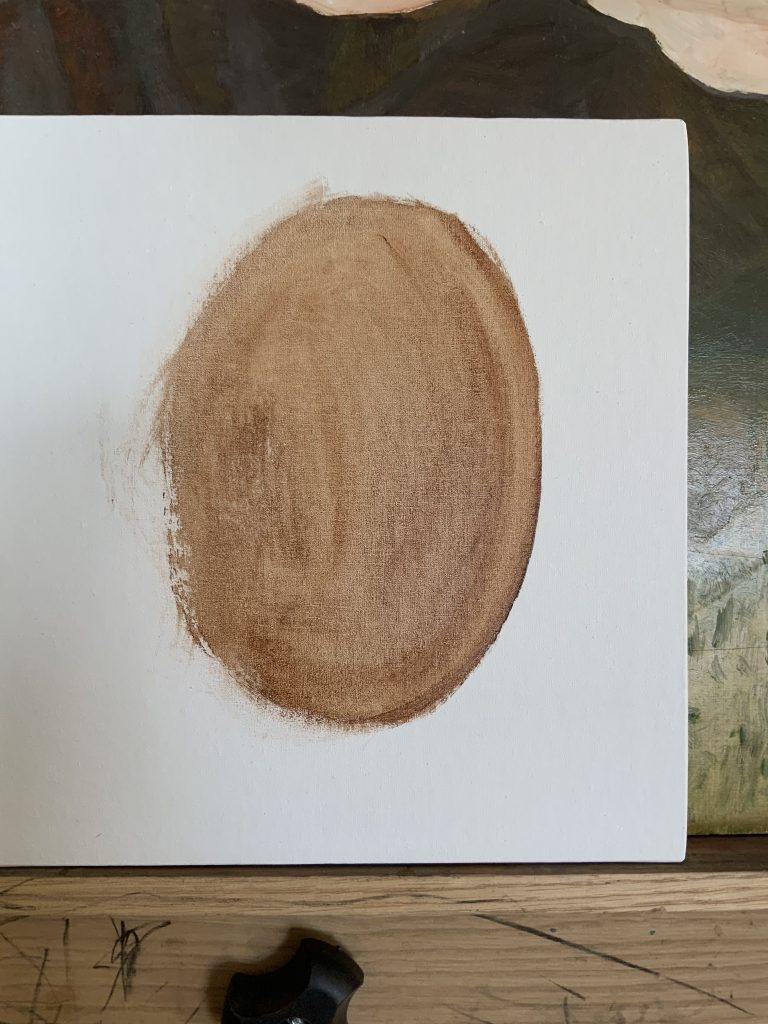
Fig. 58 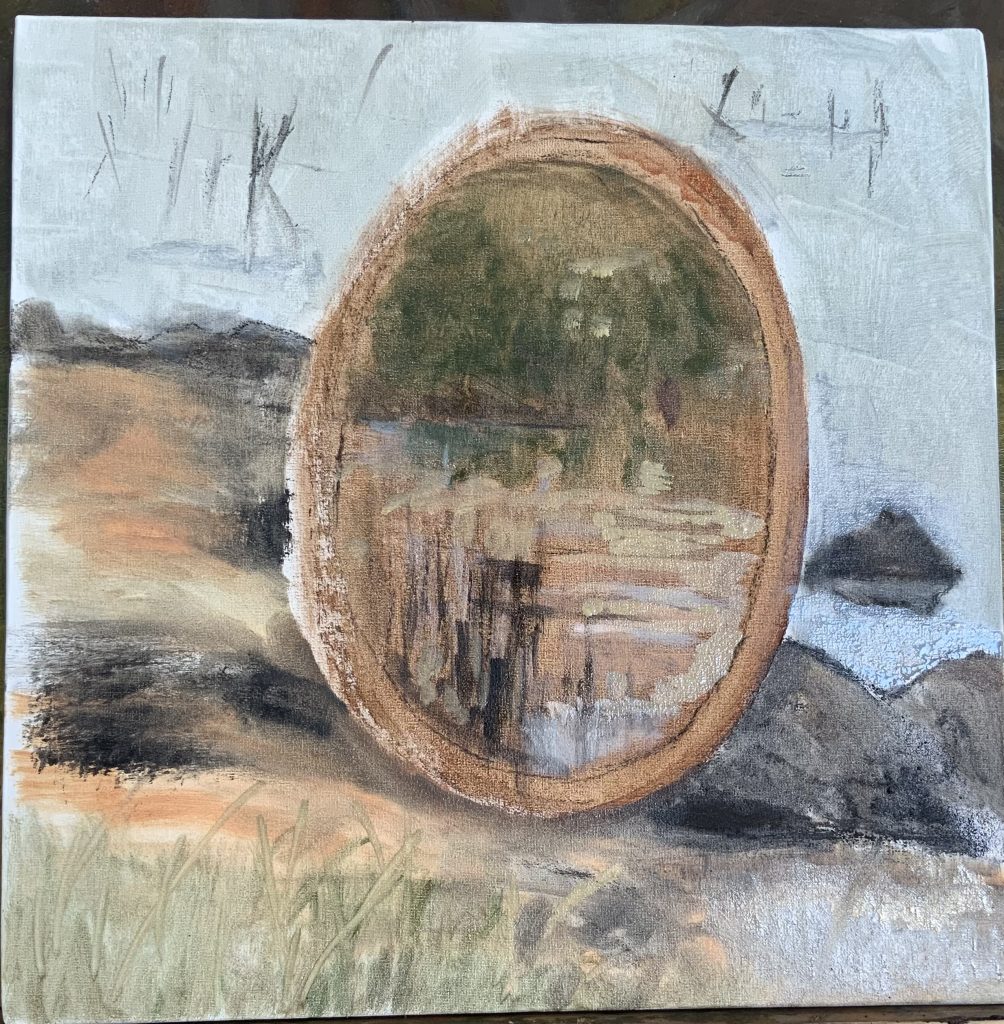
Fig. 59 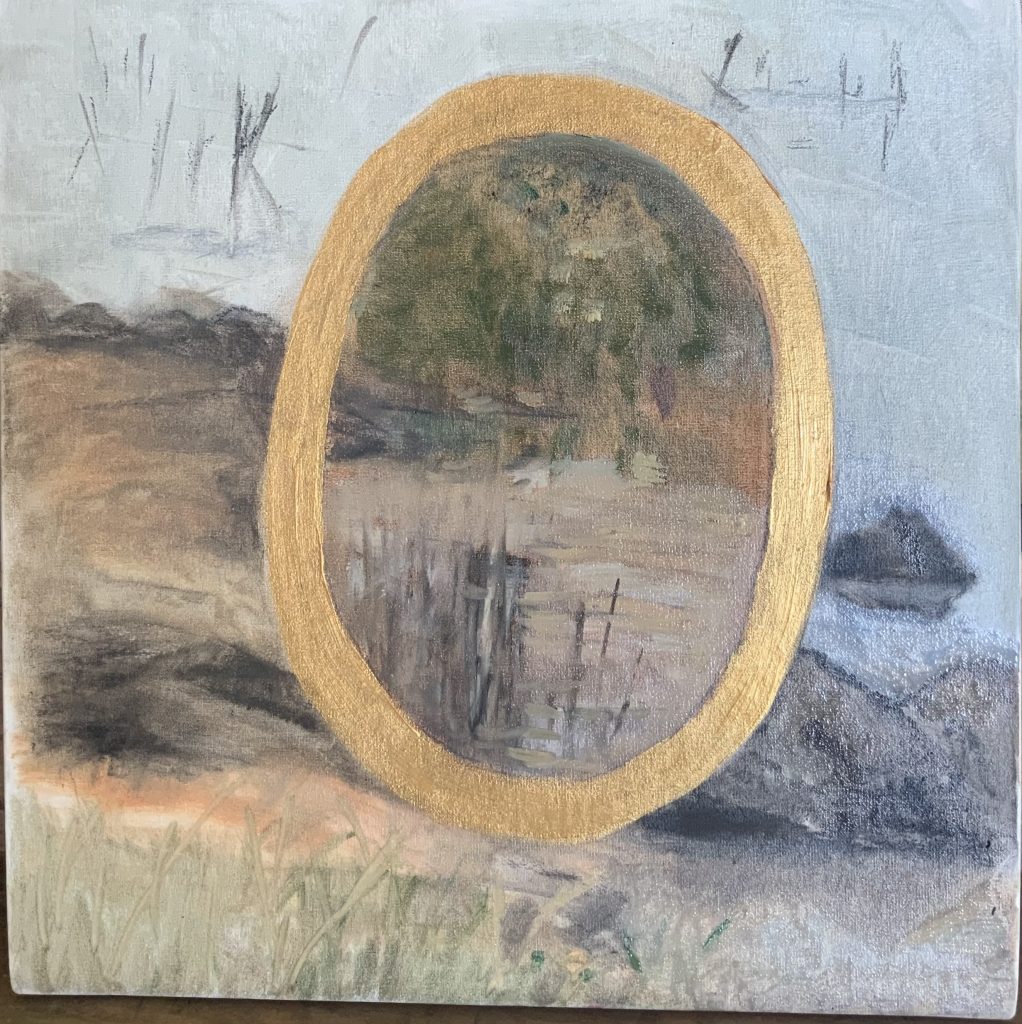
Fig. 60 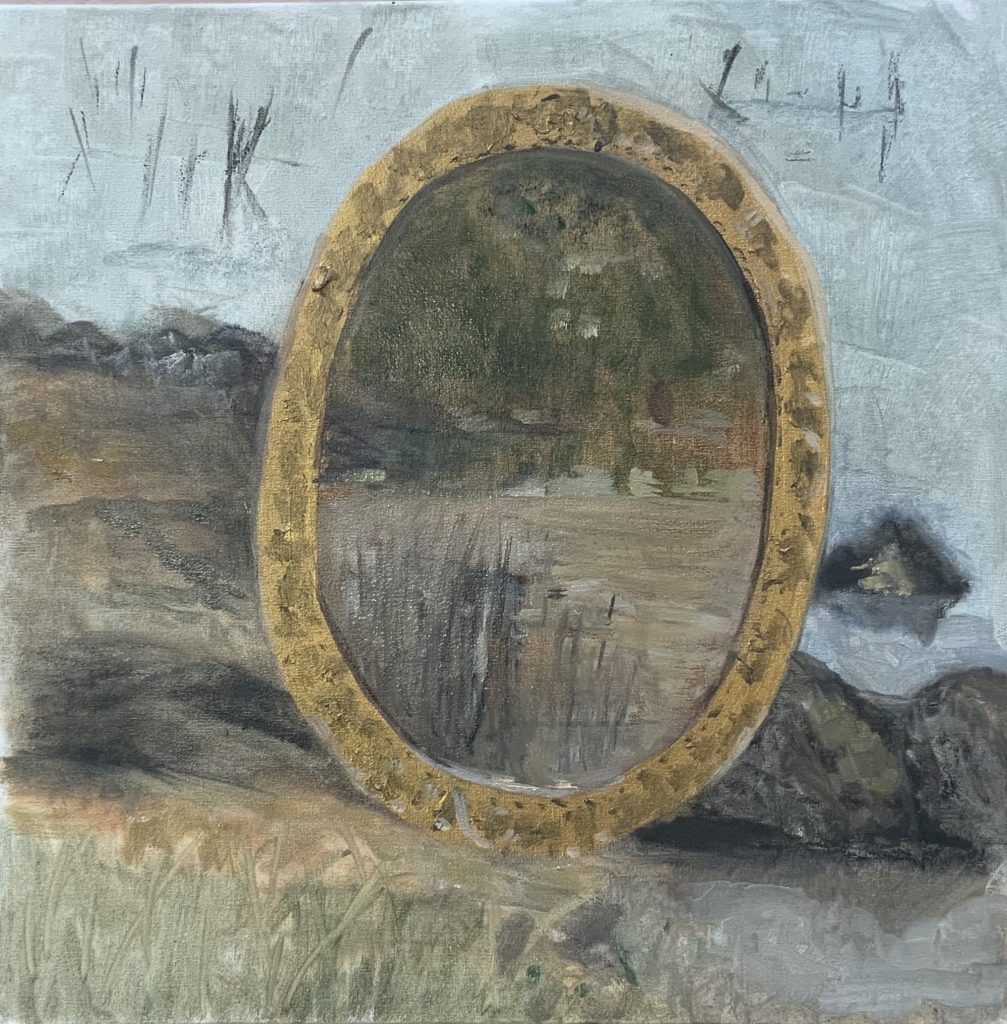
Fig. 61
The distorted view of the landscape in the mirror becomes my inspiration for the above oil painting. I work with linseed oil and OMS to create transparent layers. I think this would have worked better in watercolour. I tried to create layers by using texture and mark-making with the brushes in the paint. Somewhere in this process, I feel I think this painting is about an experience, and the viewer could take thoughts away. Maybe the mirror allows for this openness of thought.
I use soft pastels for a more transparent effect. The water becomes difficult and I need to revisit the flow of it. In the area where I need rework, I add a gesso layer to cover the previous layers of colour and lines.
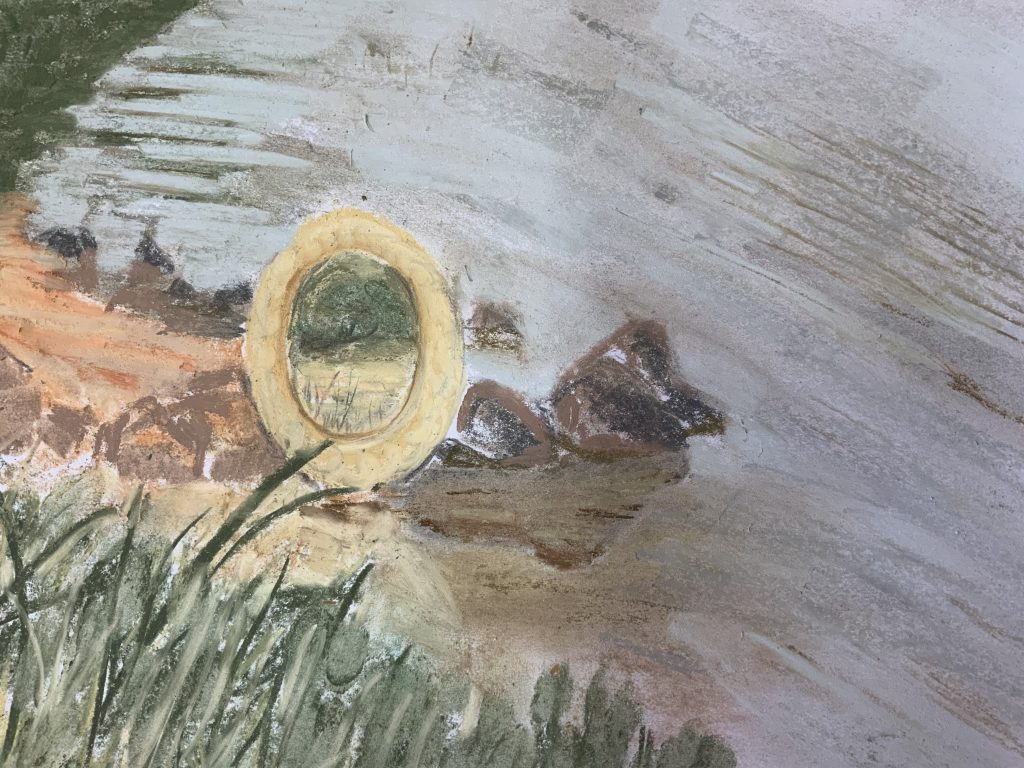
Fig. 62 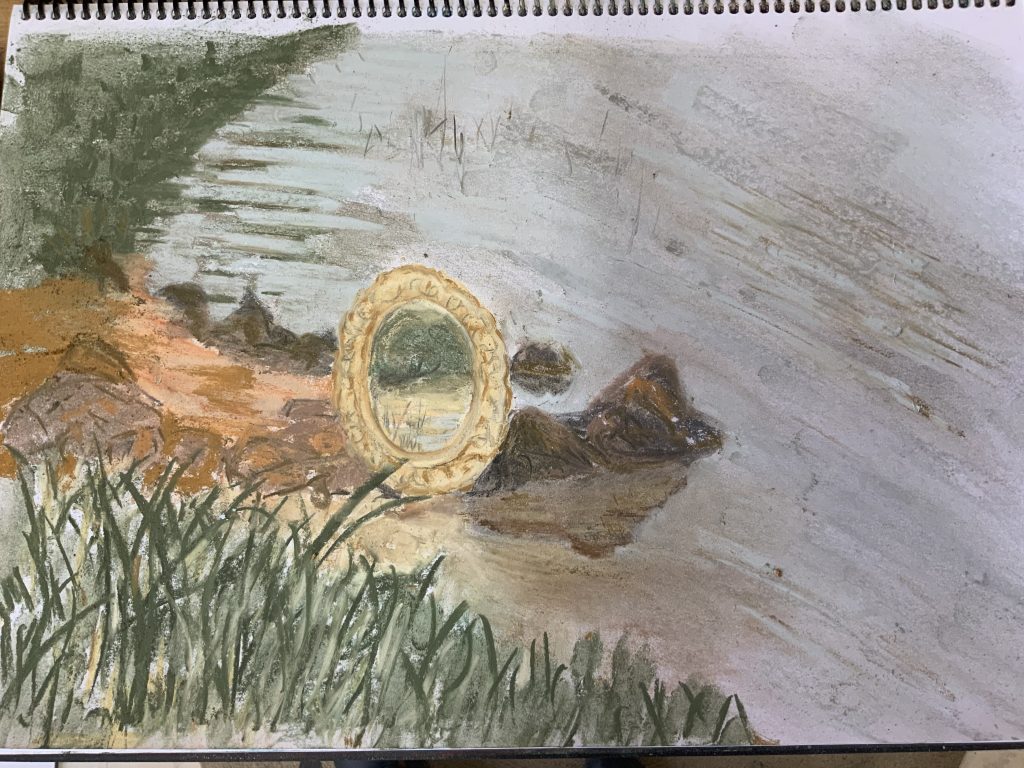
Fig. 63 
Fig. 64 – trying to hide a mistake 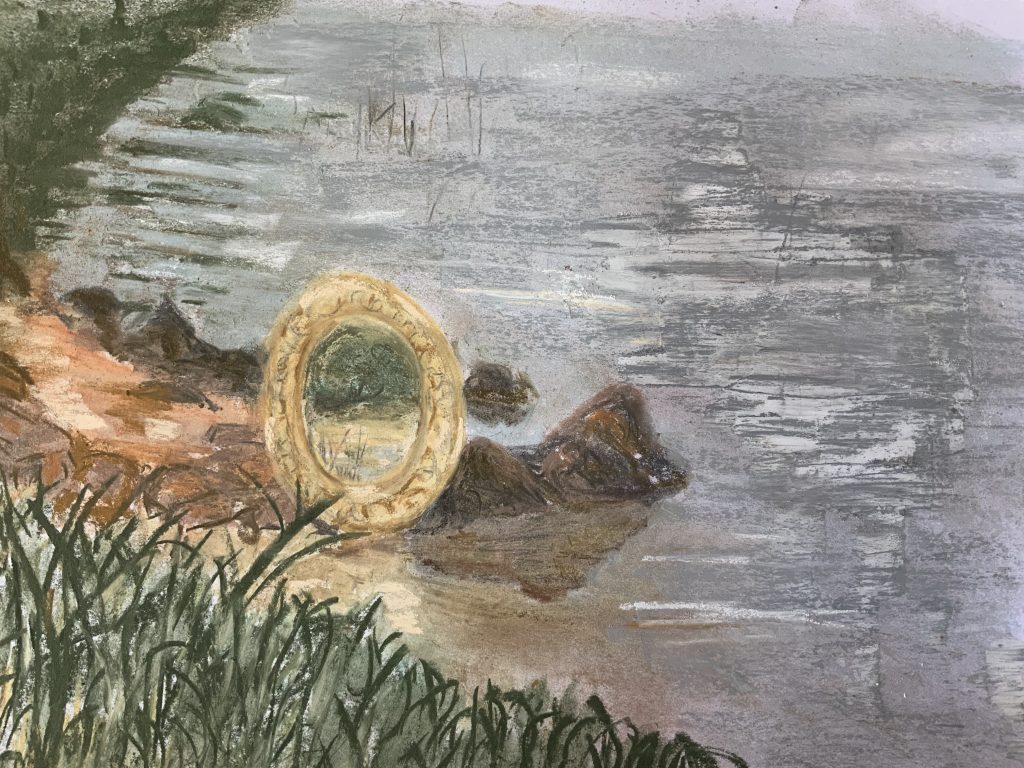
Fig. 65 Pastel of reflections at the dam, Langvlei November 2021
I have decided to continue a photographic documentation of the reflections on the dam for the next year. I will repeat that same scene monthly, and paint it (Which could be part of my parallel project) Was the idea to use transparent layers of colour to arrive at a more openness to interpretation – seeing everything in a flow, fleeting happenings, continuously changing? I am thinking of the cut as the duality of the image in a mirror. I read the following in Camera Lucida ( /51): “The incapacity to name is a good symptom of disturbance”. On Instagram, I see the work of a student who finished her photography degree at OCA recently, and who is currently doing a masters degree at St Martin’s. When we interact on the work she writes that she used a ‘bendy’ mirror. See images ( Fig. 66/67), which is screenshots from her Instagram account (with her permission) below. In the image (Fig, 67) one can see the mirror, cutting like a line between the eyes. The mirror was not used in the image (Fig. 66). I still feel one gets an idea of inward-looking. I love how she collaged different reflections into one work.
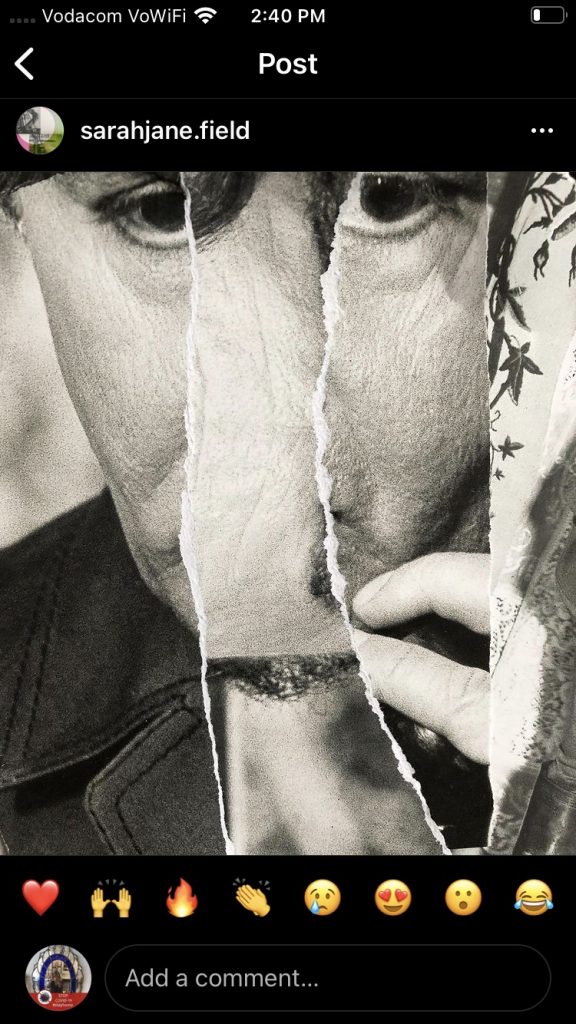
Fig 66 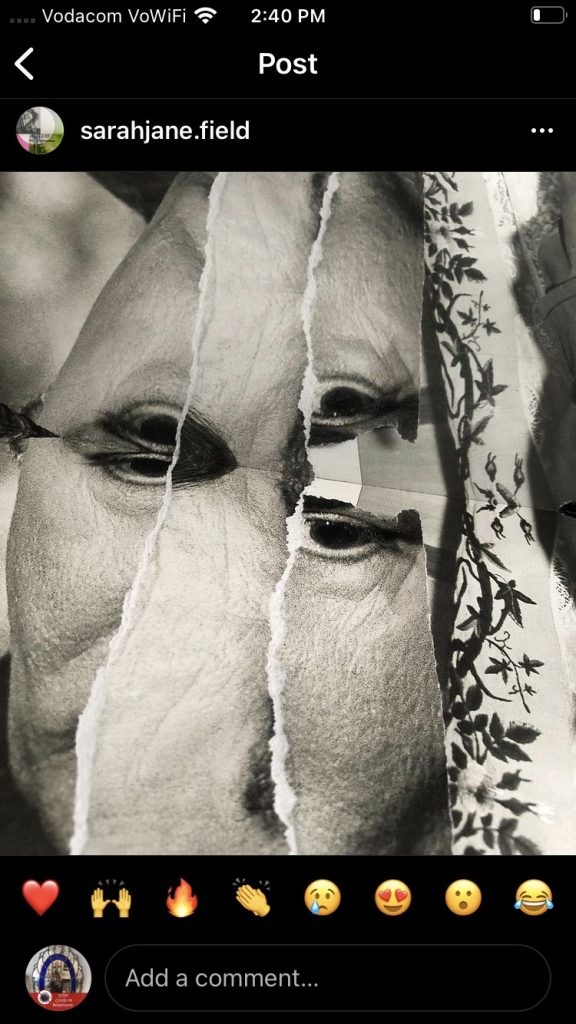
Fig. 67
I continued to explore mirrors as a stage. In the below images, the wind started blowing and the birds left some marks on the reflecting mirrors – some walked over it, others left droppings. It feels that these images are a continuation of moments.
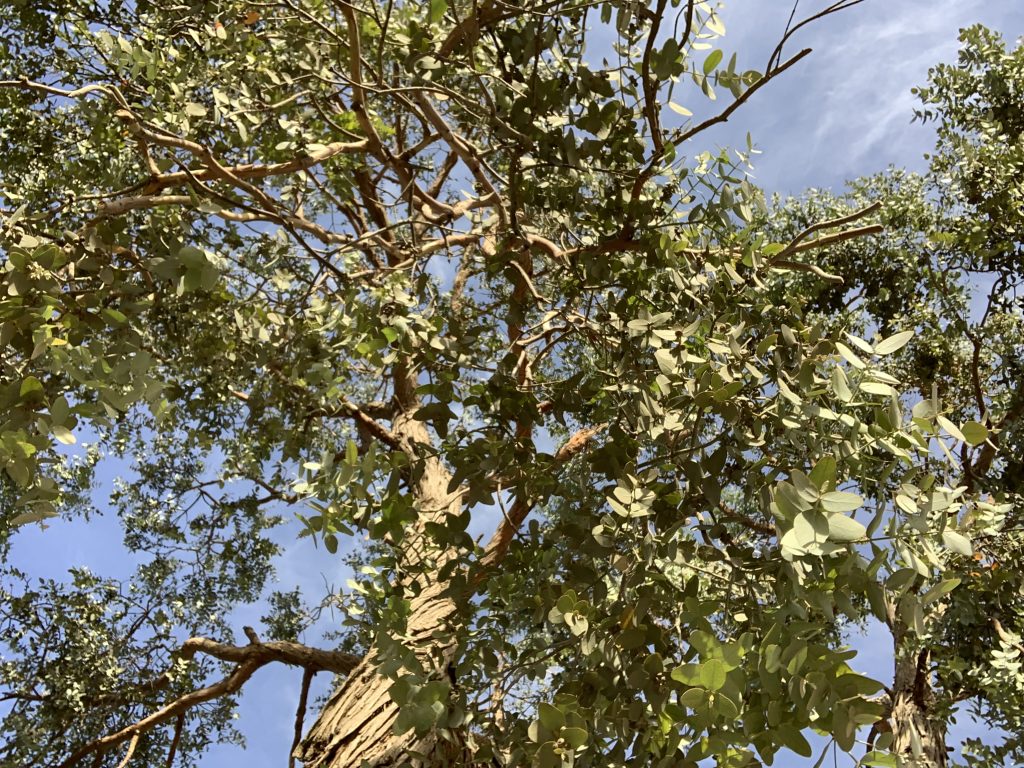
Fig. 68 
Fig. 69 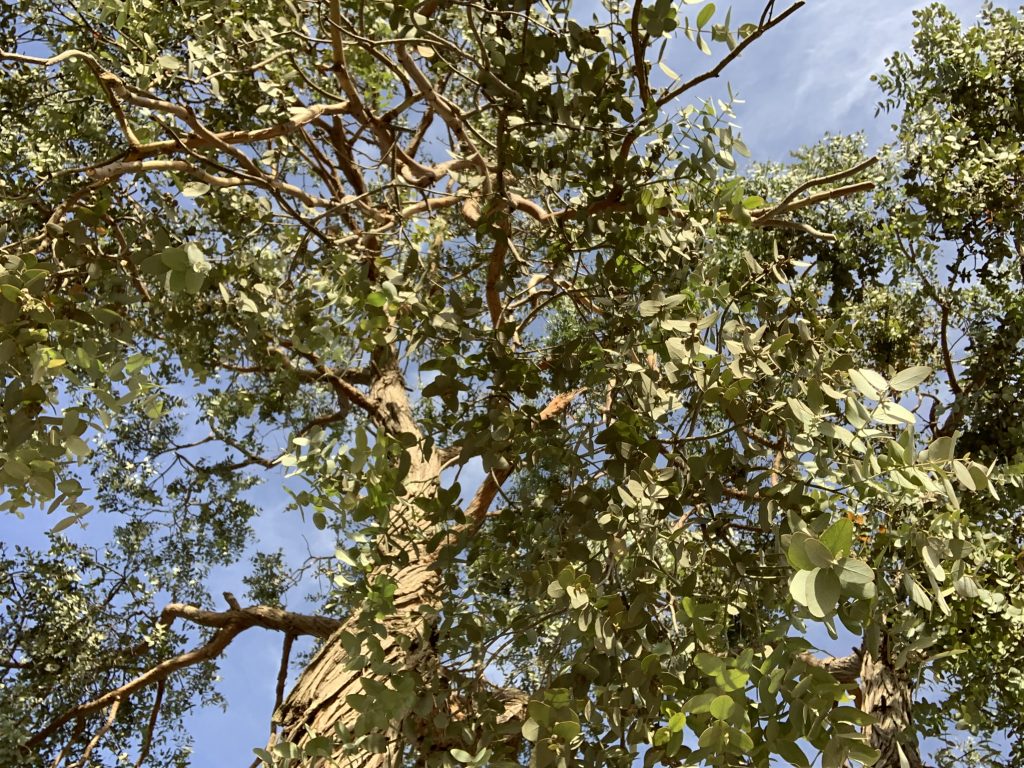
Fig. 70 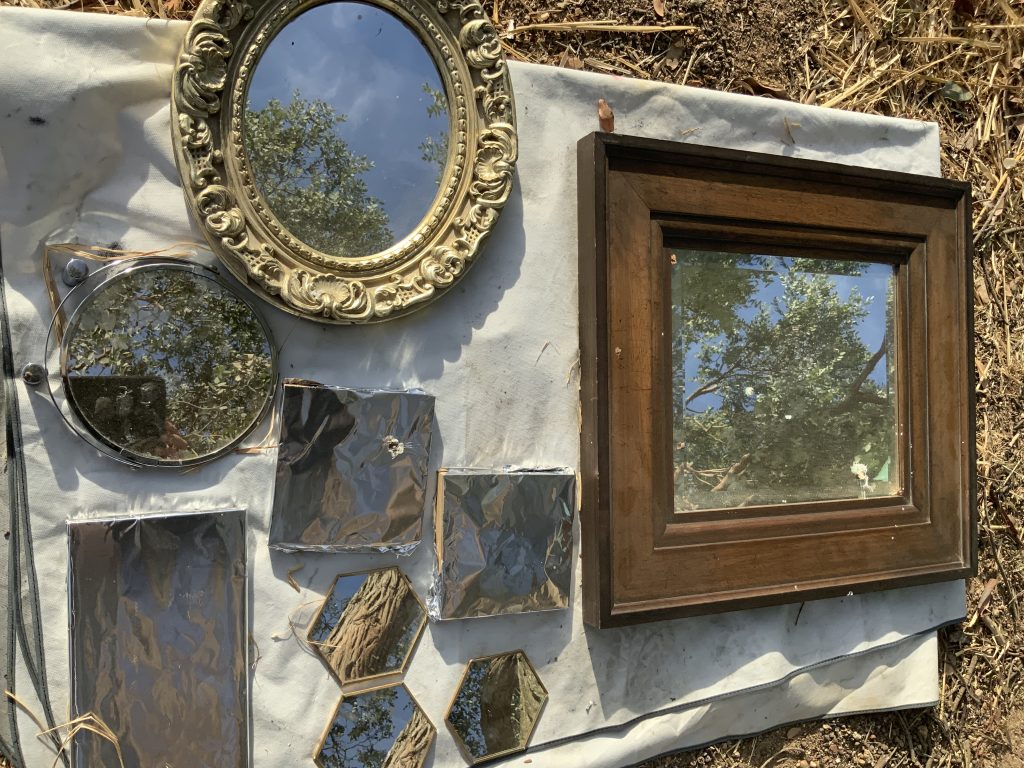
Fig. 71 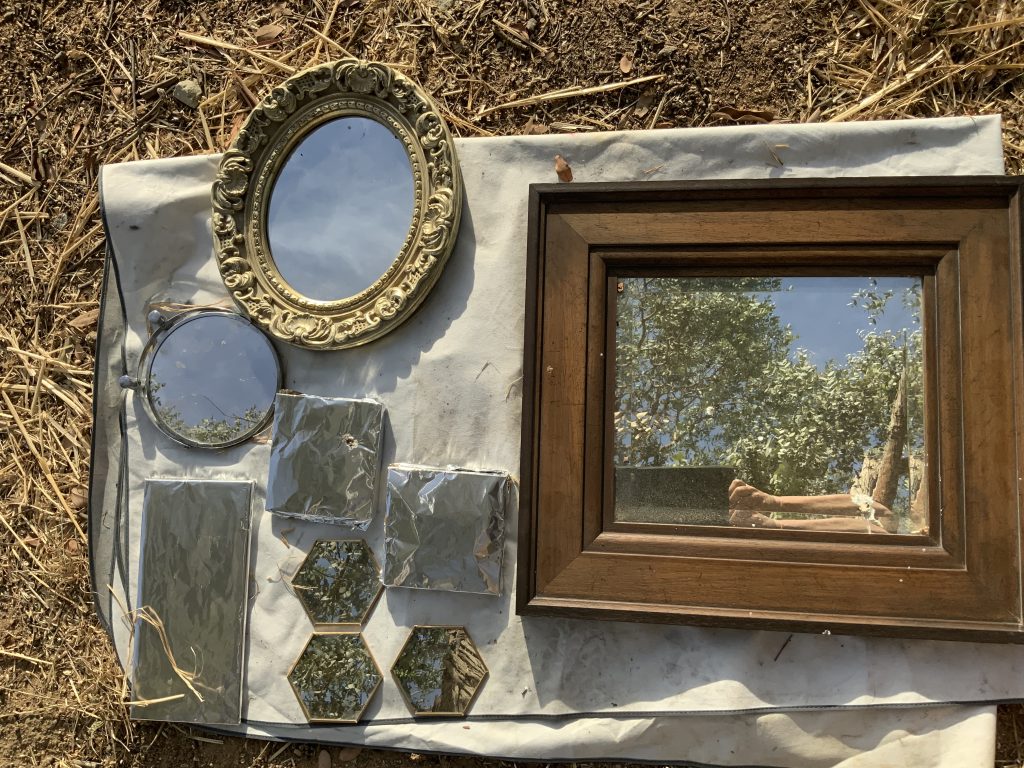
Fig. 72
Ideas developing around work I made around narrative and how a mirror could be used.

Fig. 73 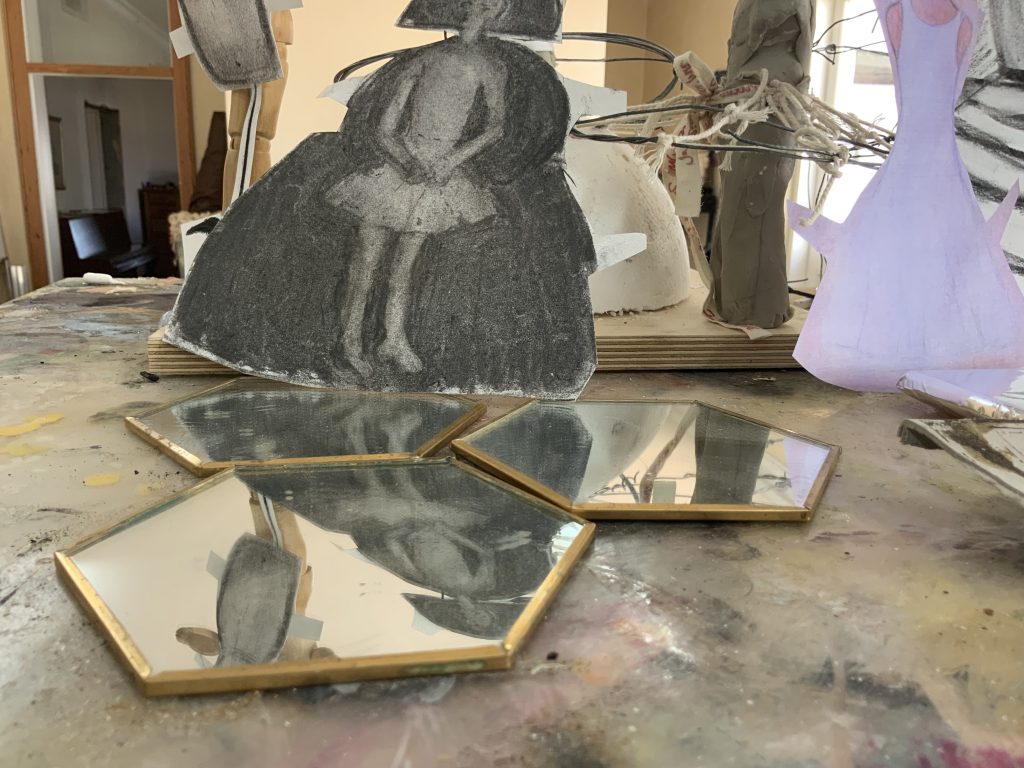
Fig. 74 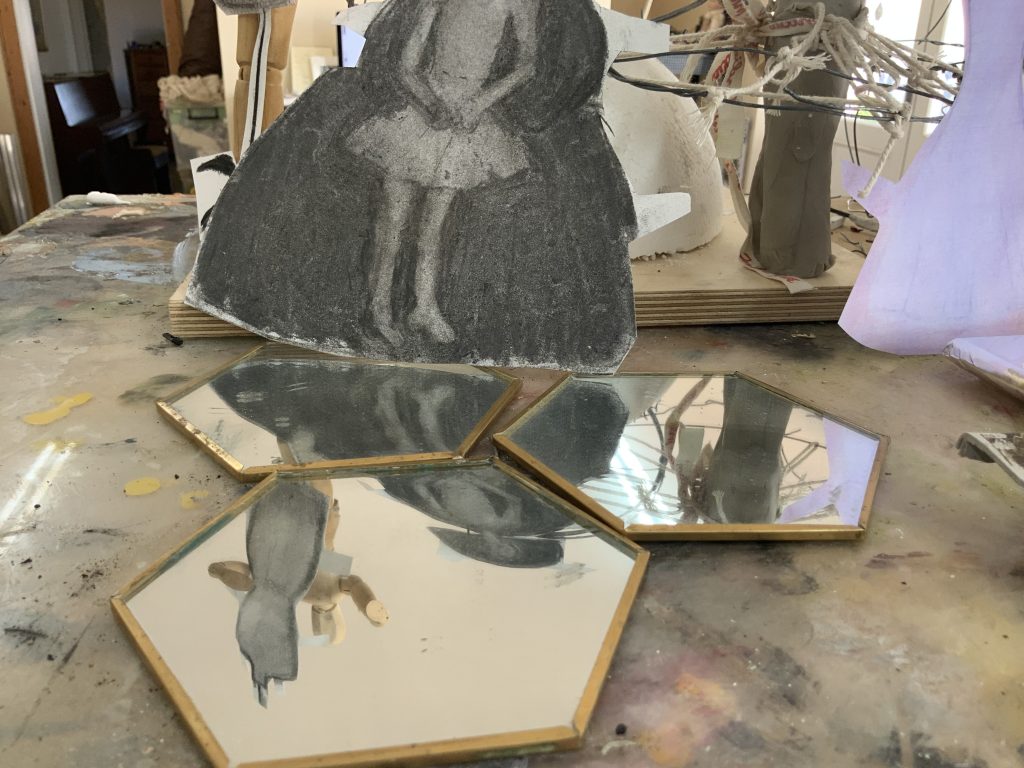
Fig. 75 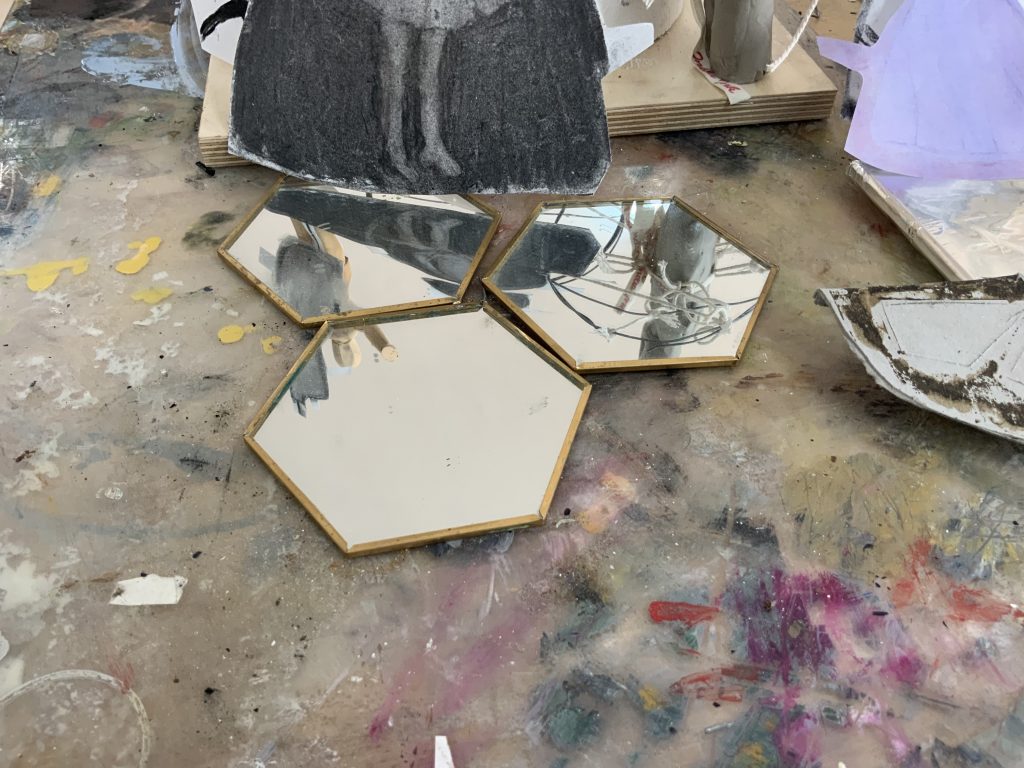
Fig. 76 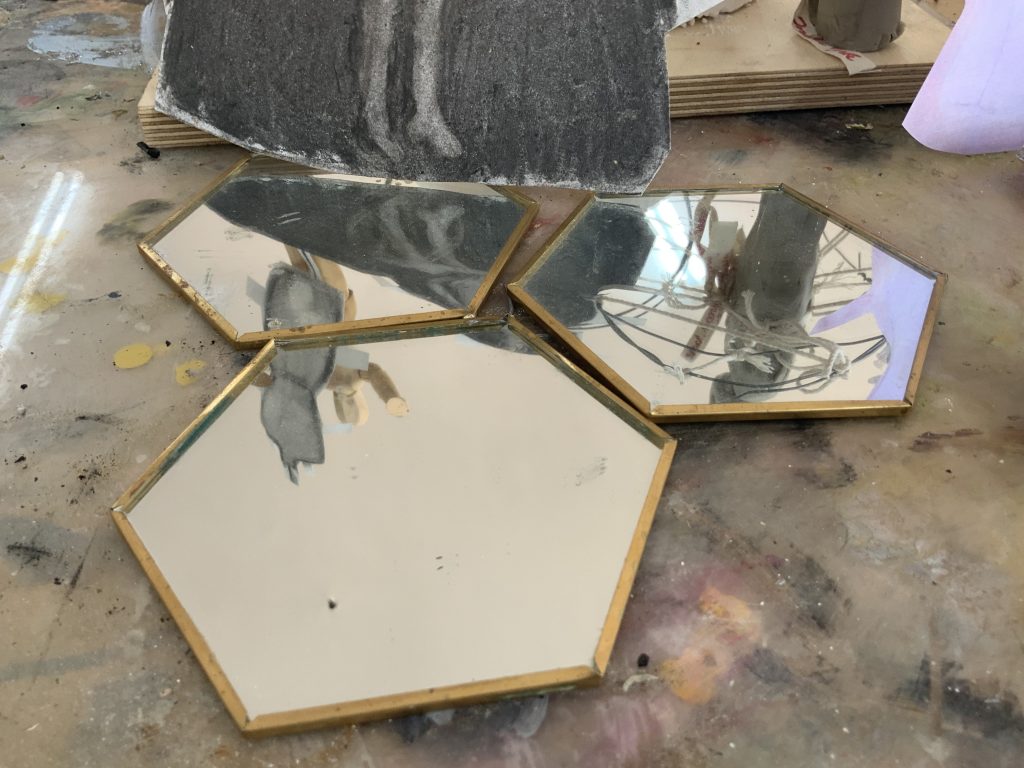
Fig. 77
I came upon the work of Joan Jonas – and the image below is in their collection and seen as a rare document of that work, shot by the artist herself. Here one view a single performer sitting in the grass holding a mirror that fragments and replicates her body into an almost Surrealist form. In both a literal and pictorial sense, Jonas denies the audience any position of stability from which to apprehend what lies before it. The mirror is used as a prop and reflects the audience, who also see themselves in the mirror and in this way brought into her work.
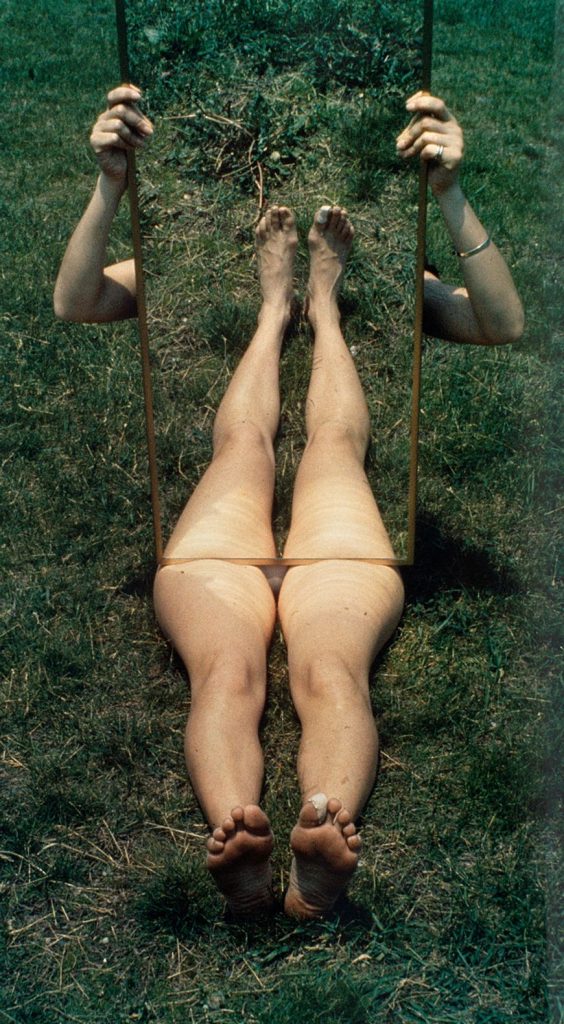
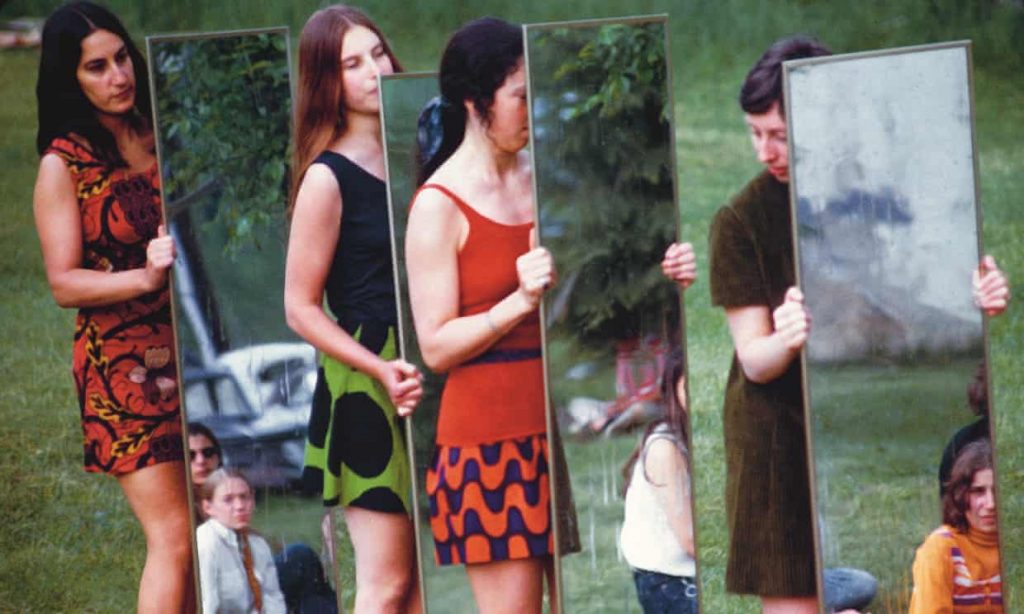
In an article with the Guardian (2018) she was quoted as saying the following: “Mirrors and poetry, as well as myth and fairytales, refract reality in unexpected ways. Mirrors can collapse or confuse the distance between performer and audience and disrupt visual frameworks. When I use a myth or a story or a literary text in my work, I often extract particular passages from a larger narrative that resonates with me. In performance, the audience hears the text, recorded in advance or recited in real-time, in fragments, and sees components – such as movements, props, drawings, and video – that may relate only indirectly to the text. I don’t change the language, but rather I change the context, which opens up the text to different possibilities of meaning. I don’t illustrate; I juxtapose.”
Developing my work into a series of performances. I will be staying with the reflections in Fig. 57 to 65. Materials to consider are ink, varnish, and water.
List of Illustrations
Fig. 1 Artists Stories: Rockaway, Katherina Grosse (2016) [YouTube Video] At: https://youtu.be/chhyDJnhIew (Accessed on 09/11/2021)
Fig. 2 Van Eyck Jan ( ) The Anolfini Portrait [Painting oil on canvas] At:
Bibliography
Barthes, Roland, Camera Lucida: Reflections on Photography , translated by Richard Howard, Monoskop download
Contextual focus ( Link 33)
It is suggested that I read Link 33 and note down my own thoughts and observations in relation to this text and my own work in my blog. It suggests that I extend my research exploring how, and to what effect, the mirror has been used in on or more of the following: film, theatre, literature. I am almost sorry that I did not read this article before I started my making.
I admire daguerreotypes and treasure one that my grandmother gave to me, of her grandparents. I experimented with the idea when I did an oil painting on a copper plate a few years ago. I realize my reason was the texture of the photograph, so different from the photographic image I used. I felt that in a way the ‘hand’ of the photographer is in the old daguerreotype works, just as my hand was in the painting on copperplate – I had to scratch through layers and worked in a limited palette. I think there is a slow down in reading such an image.
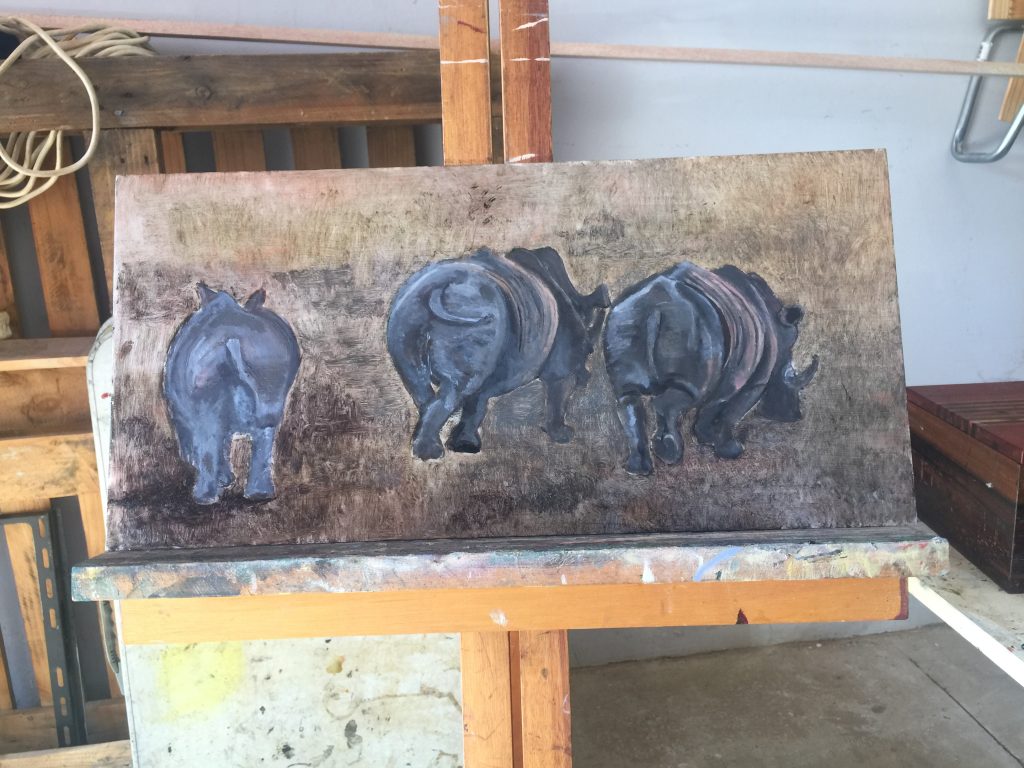
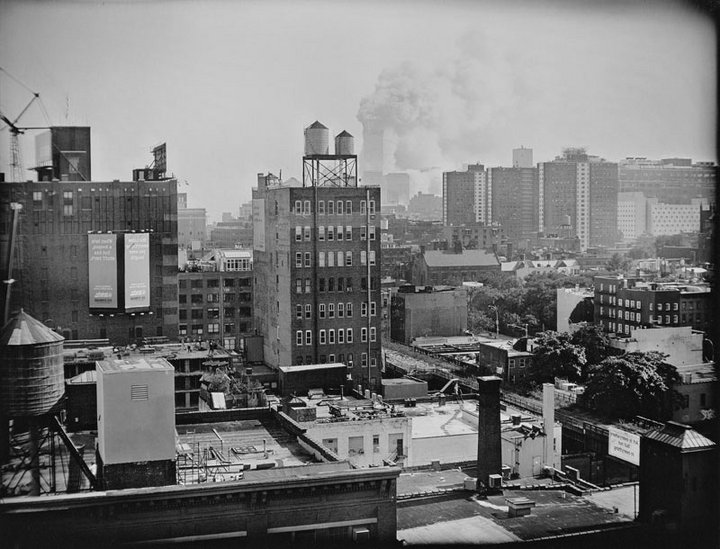
Fig. 2 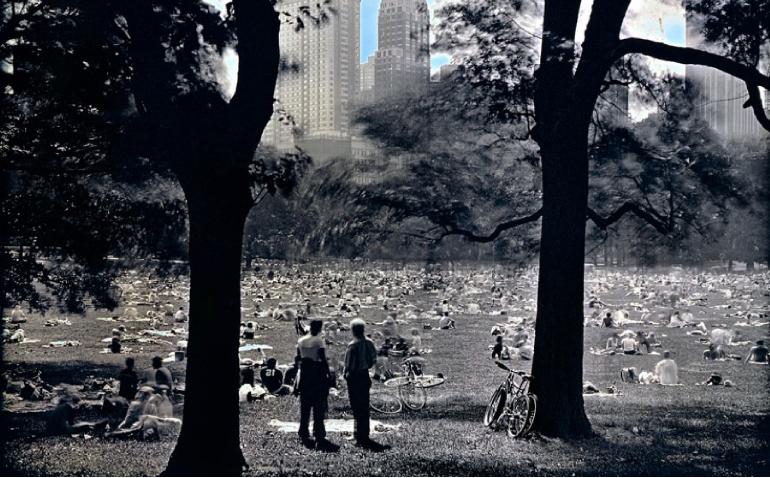
Fig. 3 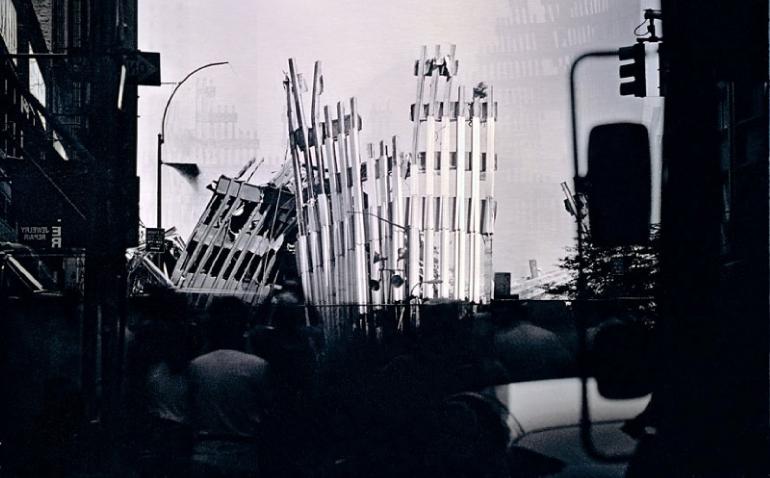
Fig. 4
I agree with Rexer that the mirror represents two poles:..” the multiplication of being through a plenitude of representations: or the negation of that power through the creation of an impossible void in the space of representation, a reflective abyss. Each type of mirror has its history, its proponents, its victims.” It is true that we almost never leave that realm of illusory representation in art history and how we understand knowledge. Looking at the artist referenced in this article it became clear that he (Jerry Spagnoli) realized how this medium would allow him to work on a project of documentary photographs that would expand upon the theme of subjectivity as the root of objective experience. The daguerreotype (photo images above) are filled with views that can give the viewer information about the city., but because it is rendered to give the experience of the image as very real, but being small, limited colour, and slow type exposure, there is also a way that this medium is elusive and makes one search for reality or truth in the image. ( the lack of technology?) It seems one can also see this as the interplay between information and knowledge. It is about how we ‘read’ the world around us, which I find was the biggest learning for me in this project. I realize that my mind depicts what I see – and that is not always all that is out there in the world around me. To me, it confirms that this mirror then also replies to inner things – and in the art-making, we are busy with a process of ‘unearthing’ this – it is a continuous learning process. Looking at the photographic process, the technical or technological advances have been tremendous, and that has an impact on how we look. We can easily replace viewing the real thing and stick to looking at digital images online. When we say that art is a mirror for the viewer in terms of our reality, that really becomes an important question to consider when we think about making or creating art as an enactment/reenactment and that agency it holds.
Children’s story, SnowWhite, and the line, “Mirror mirror on the wall, who is the fairest of them all” takes one to fantasy. If I remember correctly the Queen ‘entered’ the mirror when the mirror started ‘talking’. I was captured by this magic happening between the mirror and the Queen. I do feel irritated by the story now – not the magic, but the vanity and ideas of beauty and youth. At least the Queen’s vanity destroys her in the end.
I found the following opinion whilst looking at film and how mirrors have been used: “Mirrors are reflections and duplications of reality, which can be said of cinema itself; the introduction of this “meta” element between reality, cinema and reflection is often the very reason why filmmakers choose to use mirrors as part of their works.” (Basso, 2016). I understand that the role of the mirror connects the viewer, in an emotional and bodily way – we think, reflect, laugh, cry, get upset, fear — confrontational and provocative.
“I want to expose and evaluate the fact that the seeing and sensing process is a system that should not be taken for granted as natural – it’s a cultivated means of reality production that, as a system, can be negotiated and changed.” O Eliasson
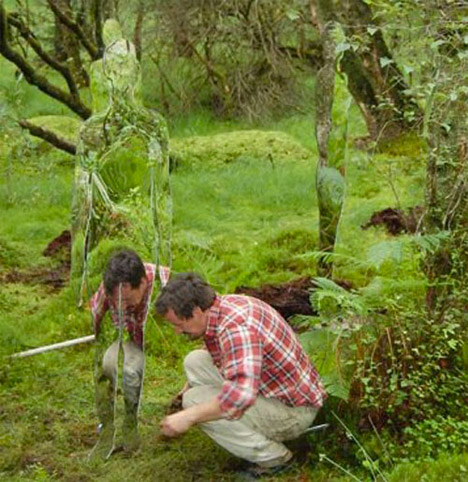
Basso, Ricardo, 2016 , The 20 Best Uses of Mirrors in Cinema History, website visited http://www.tasteofcinema.com/2016/the-20-best-uses-of-mirrors-in-cinema-history/
Guardian, March 2018 Mirror mirror: Joan Jonas on the fairytales that have cast a spell over her 50-year career. https://www.theguardian.com/artanddesign/2018/mar/22/joan-jonas-exhibition-tate-modern-london
Rexer, Lyle, 2010 The multiplication of being, or a reflective abyss? Mirrors
Spagnoli, Jerry, website http://www.jerryspagnoli.com/The%20Last%20Great%20Daguerreian%20Survey/thelastgreatdagu.html